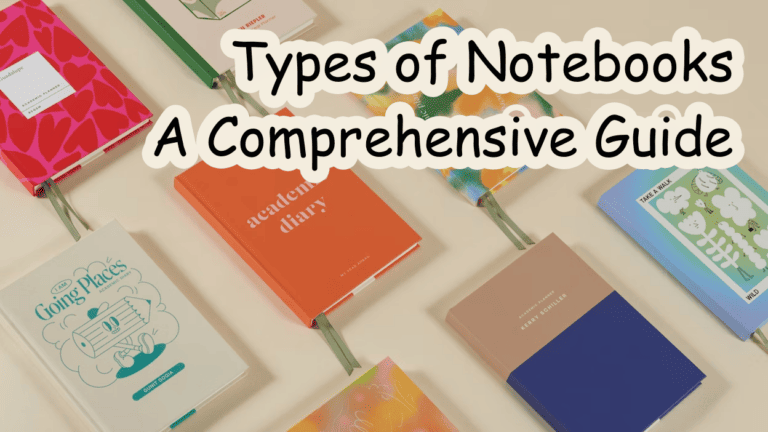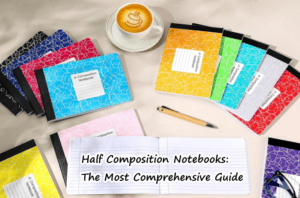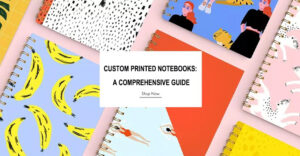In today’s digital age, notebooks remain an essential tool for jotting down thoughts, ideas, and information. With a wide range of options available, each designed to cater to specific needs and preferences, choosing the right notebook can be a daunting task. Whether you’re a student, a professional, or simply someone who loves to journal, understanding the different types of notebooks can greatly enhance your writing experience. In this article, we’ll delve into various notebook types, their features, and how to select the perfect one for your needs.
introduction
With a plethora of options available, it can be overwhelming to choose the right types of notebooks that suit your specific needs. Classifying various notebooks can be done based on their characteristics, purposes, sizes, binding methods, and other factors.
Let’s explore the diverse world of notebooks together, from classic paper notebooks to digital counterparts.
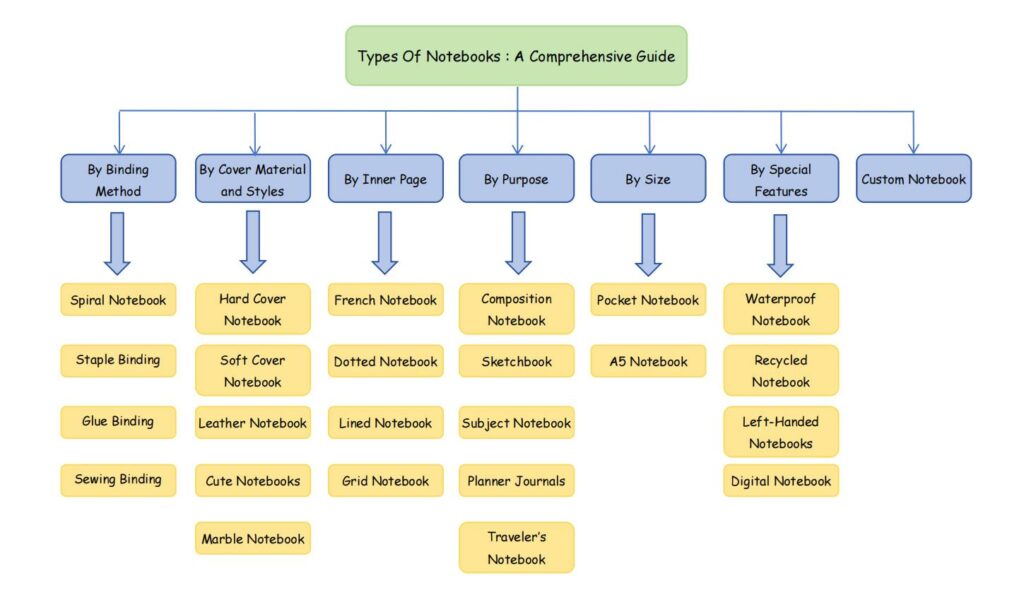
1. By Binding Method
When classifying notebooks by their binding methods, it’s important to consider the various ways in which pages are held together to create a functional and organized writing platform. The choice of binding method can impact the notebook’s durability, ease of use, and overall appearance. Let’s explore some common binding methods used for types of notebooks.
1.1 Spiral Notebook
A Spiral Notebook is a versatile and commonly used stationery item that combines functionality with convenience. Its defining feature is the spiral wire binding that holds the pages together, allowing for easy page flipping and smooth writing. This type of notebook comes in various sizes, ranging from pocket-sized to larger formats, catering to different needs and preferences.
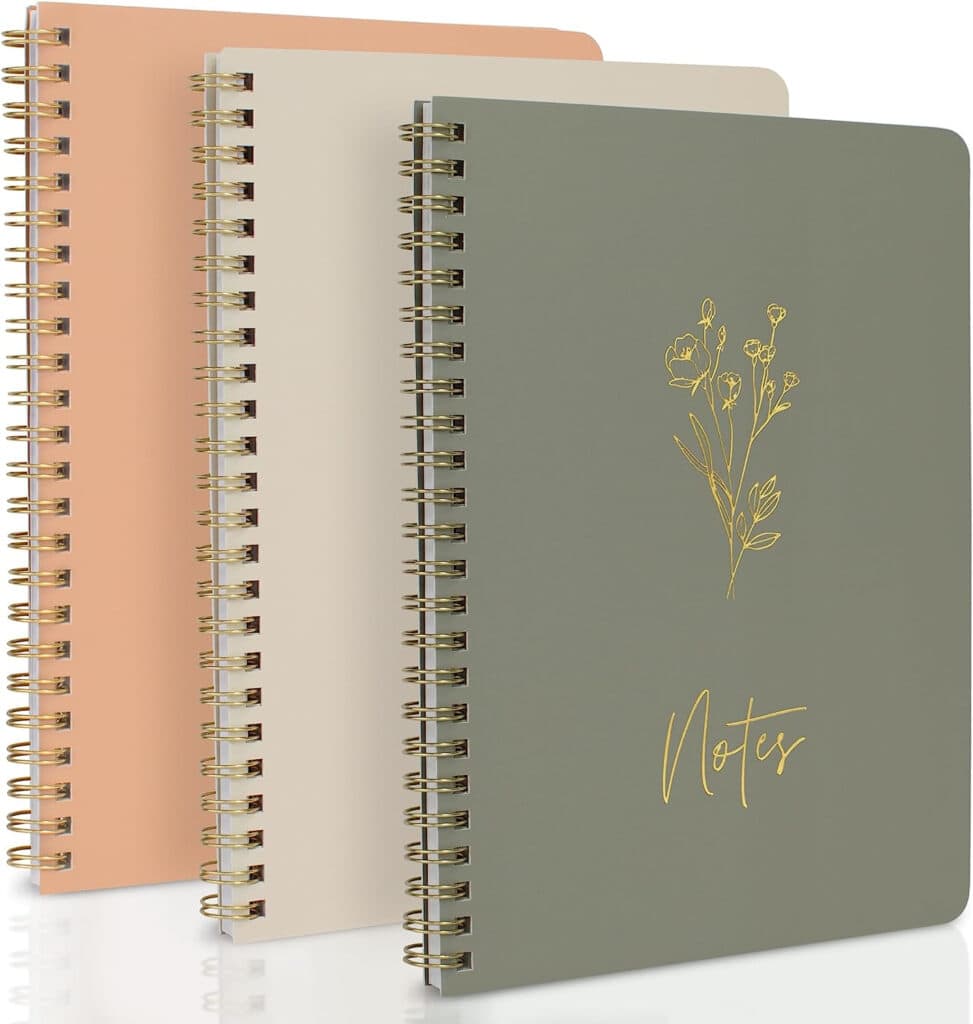
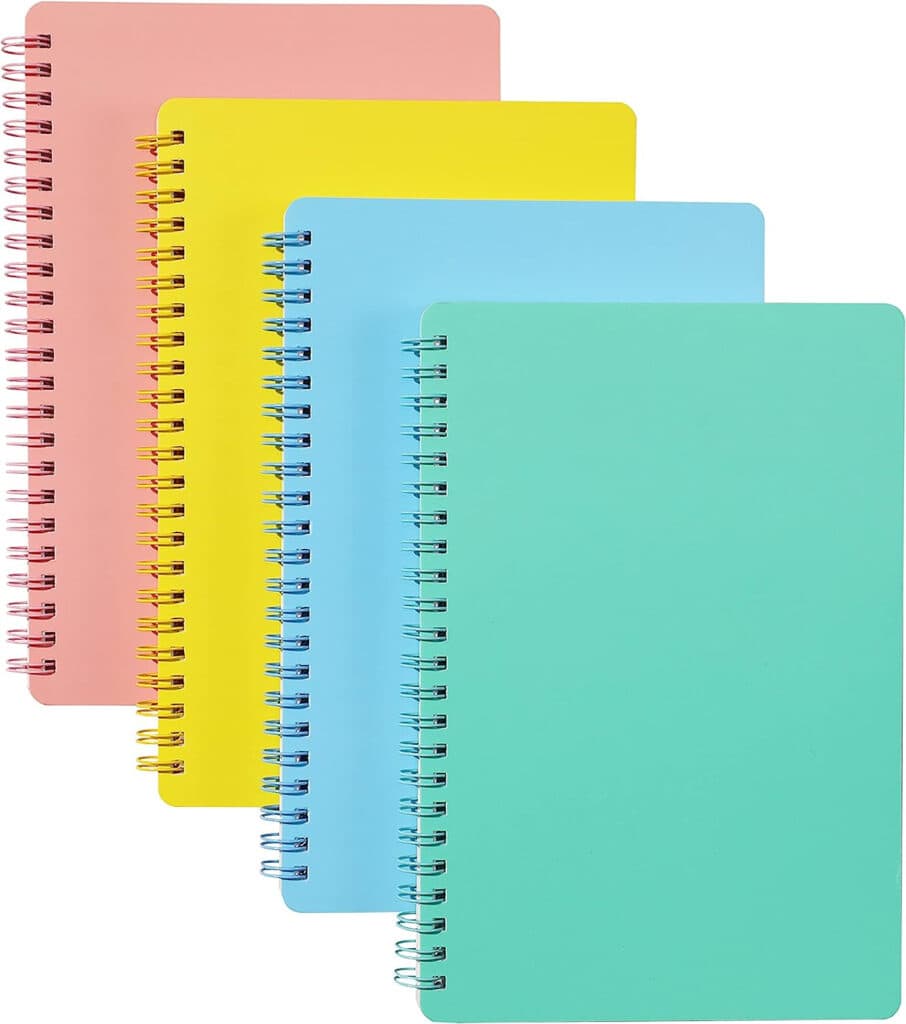
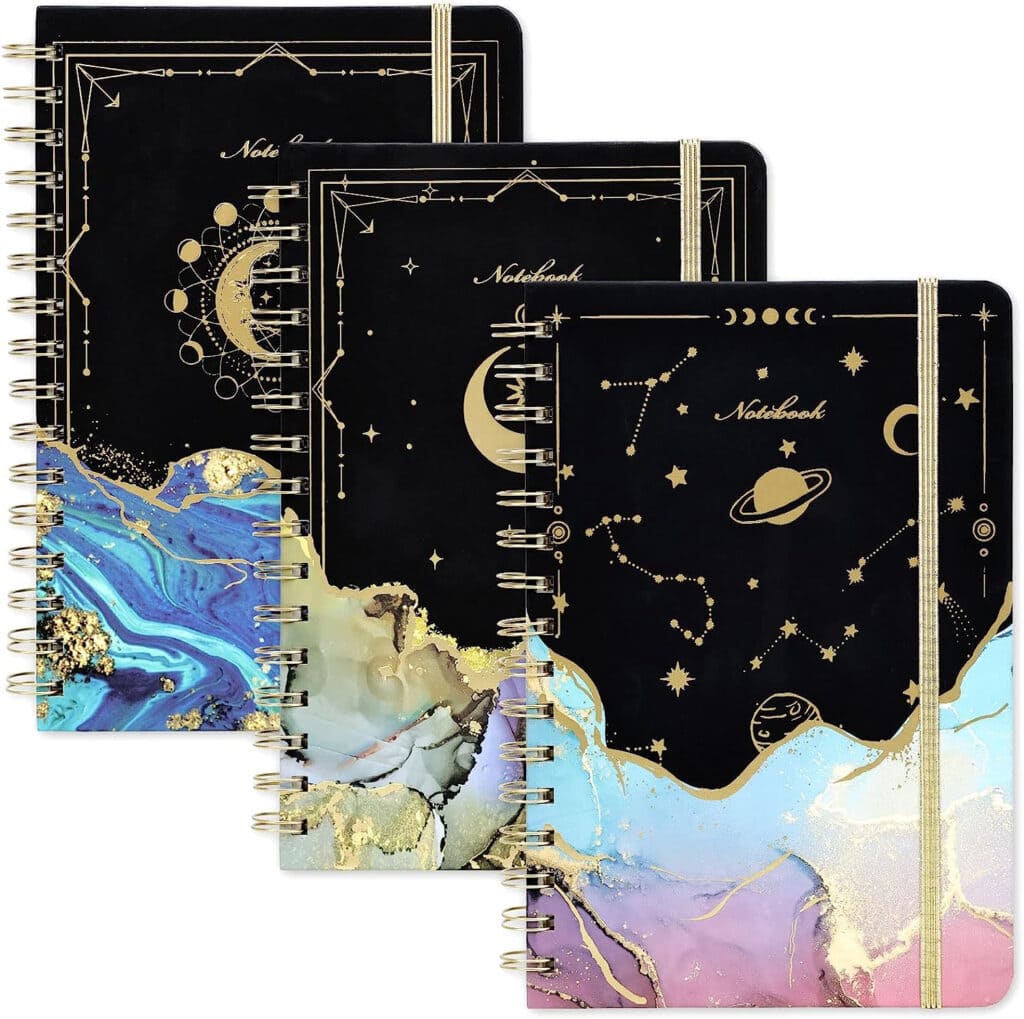
Common Use: Spiral notebooks are popular among students, professionals, artists, and anyone who needs a portable and accessible platform for note-taking, sketching, or brainstorming. The spiral binding enables the notebook to lie flat on surfaces, which is particularly advantageous during meetings, classes, or when you’re working on a project that requires referring back to your notes frequently. (Spiral Binding Notebook: The Most Comprehensive Guide)
Pros:
- Page Flipping: The spiral binding allows pages to be turned easily and keeps the notebook open without the need to hold it down.
Lays Flat: The notebook lies flat, providing a comfortable and stable writing surface.
Affordability: Generally cost-effective, making them accessible to a wide range of individuals.
Cons:
- Page Tears: Pages can tear out more easily compared to notebooks with sewn or glued bindings.
Durability: The spiral wire can sometimes become bent or damaged, affecting the notebook’s lifespan.
1.2 Staple Binding Notebook
A staple binding notebook, also known as a saddle-stitched notebook, is a simple and cost-effective type of notebook binding method. In this binding technique, folded sheets of paper are stacked together and then stapled along the fold line, creating a secure and functional notebook.
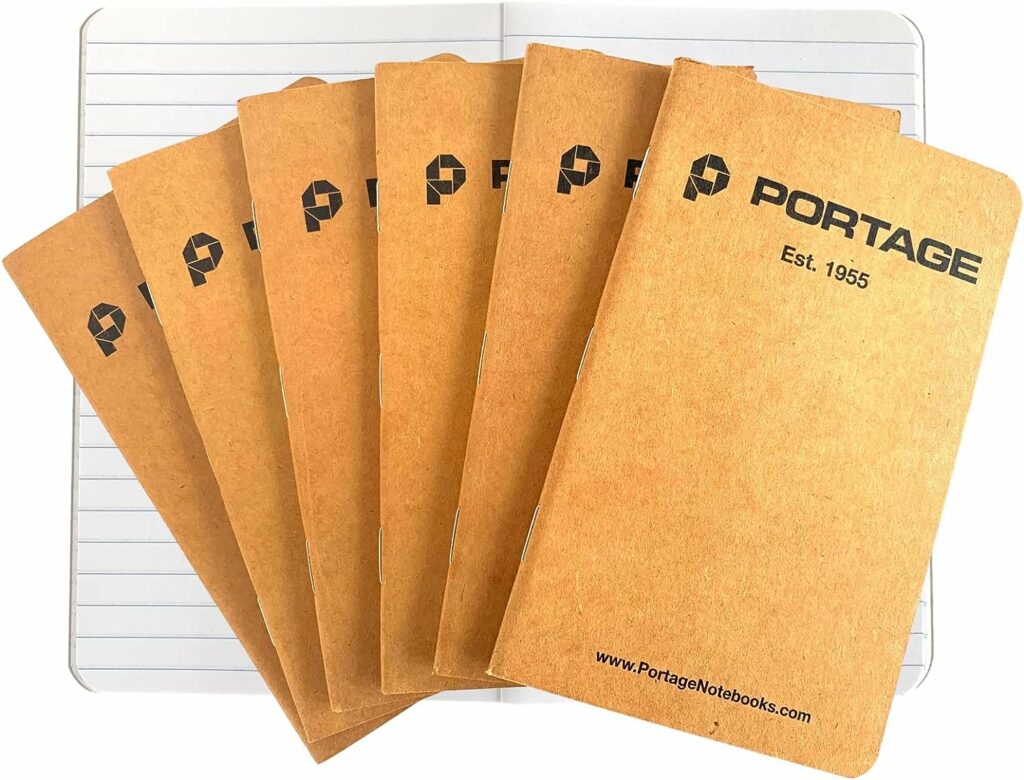
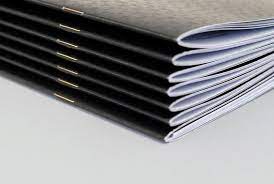
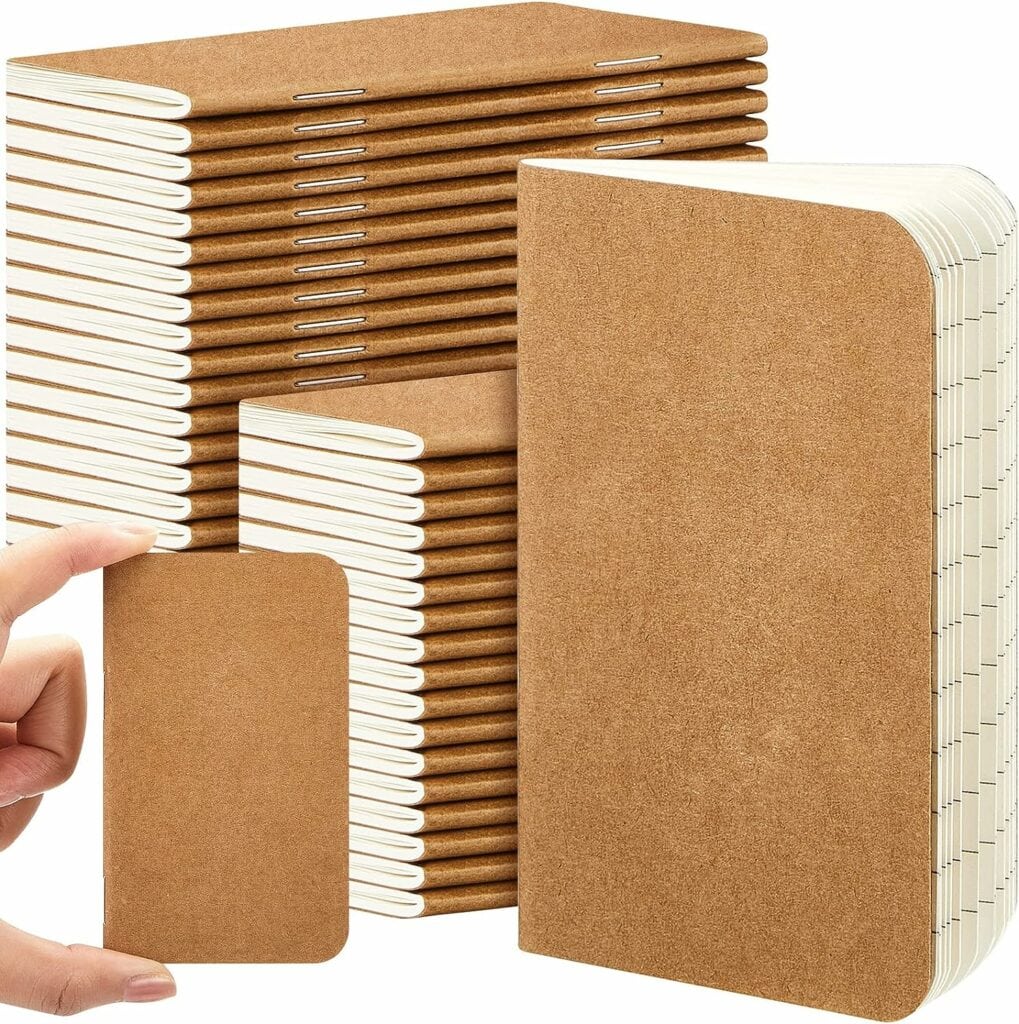
Common Use: Staple Binding Notebooks are commonly used for quick and temporary note-taking, brainstorming, sketching, and other informal uses. They are often found in educational settings, workshops, and meetings where practicality and affordability are prioritized.
Pros:
- Cost-Effective: Staple binding is an economical binding method, making these notebooks budget-friendly.
- Lays Flat: The notebook can easily lay flat when opened, providing a convenient writing surface.
- Easy to Produce: Staple binding is a straightforward process, allowing for efficient and quick production.
Cons:
- Limited Durability: Staple binding may not be as durable as other binding methods for long-term use.
- Page Limitation: The number of pages that can be stapled together is limited by the stapling capacity.
1.3 Glue Binding Notebook
A glue binding notebook is a type of notebook that features pages that are securely bound together using adhesive glue. This binding method provides a clean and seamless appearance, creating a sleek and professional-looking notebook.
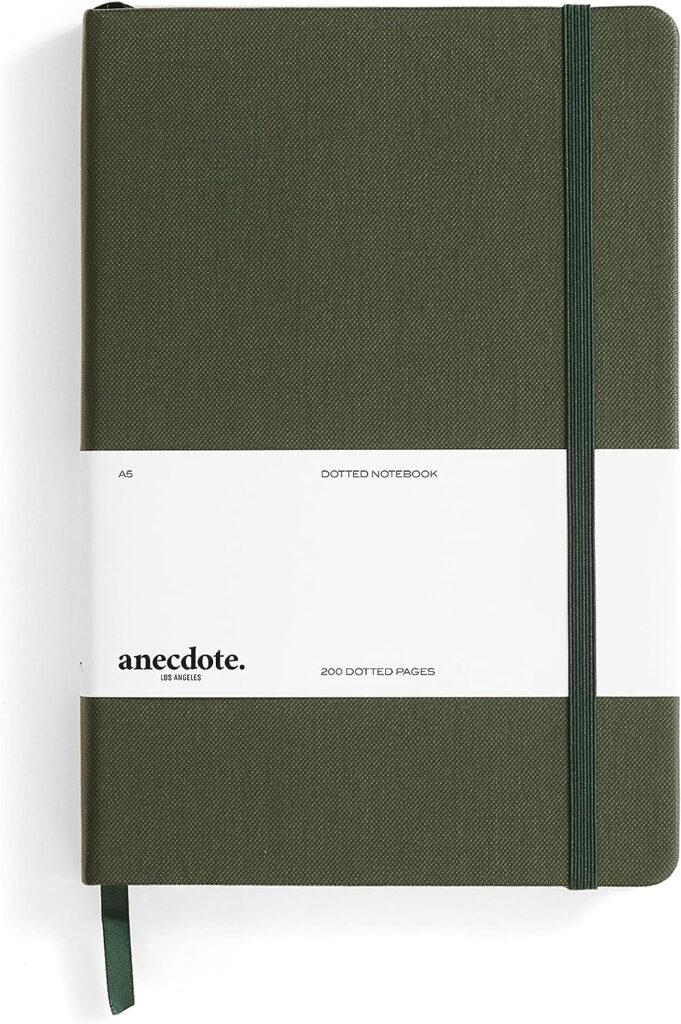
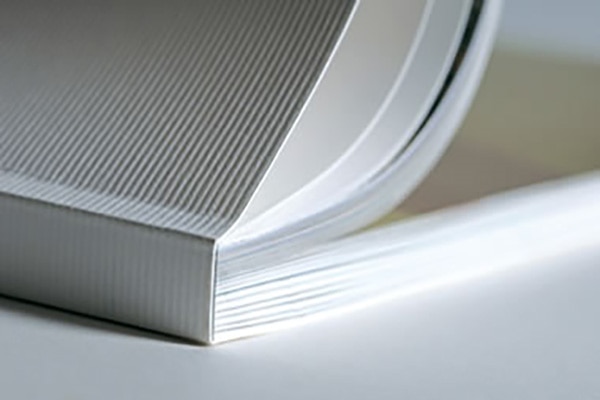
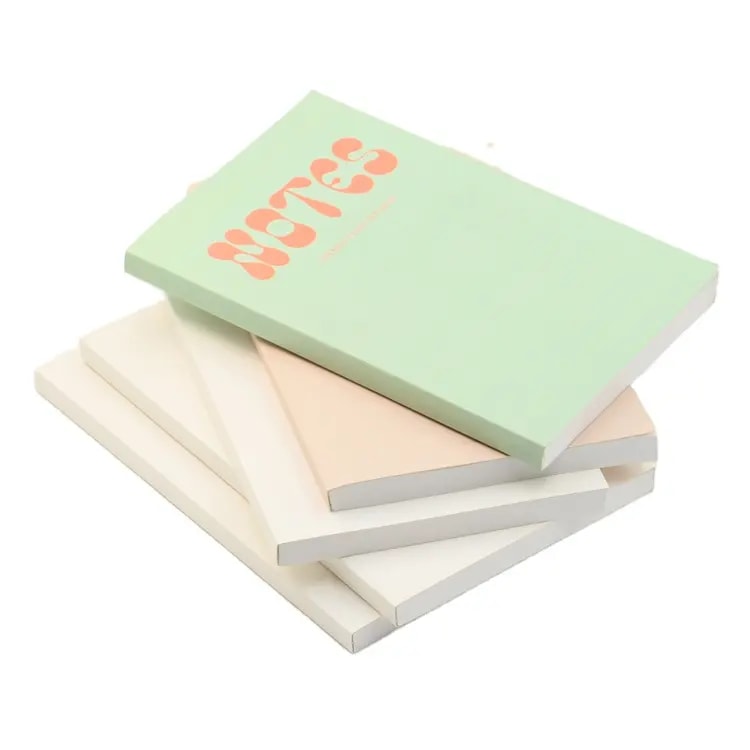
Common Use: Glue binding notebooks are widely used for a variety of purposes, including note-taking, writing, journaling, and sketching. They are often found in educational settings, offices, and for personal use, offering a versatile platform for capturing thoughts and ideas.
Pros:
- Clean Appearance: Glue binding results in a neat and cohesive appearance, enhancing the overall aesthetic of the notebook.
- Customization: Glue binding allows for a range of notebook sizes and paper types, catering to different preferences.
- Suitable for Long-Term Use: When produced with quality materials, glue-bound notebooks can be durable for extended use.
Cons:
- Limited Page Removal: Once pages are glued together, it may be difficult to remove or add pages without damaging the binding.
- Durability: The durability of glue binding depends on the quality of the adhesive and materials used.
- Production Complexity: While not as complex as other binding methods, glue binding still requires careful production to ensure pages are evenly adhered.
1.4 Sewing Binding Notebook
A Sewing Binding Notebook is a type of notebook that is constructed by sewing together the individual signatures (groups of folded pages) through the fold line. This traditional and durable binding method ensures that the pages are securely held together and can withstand extended use.
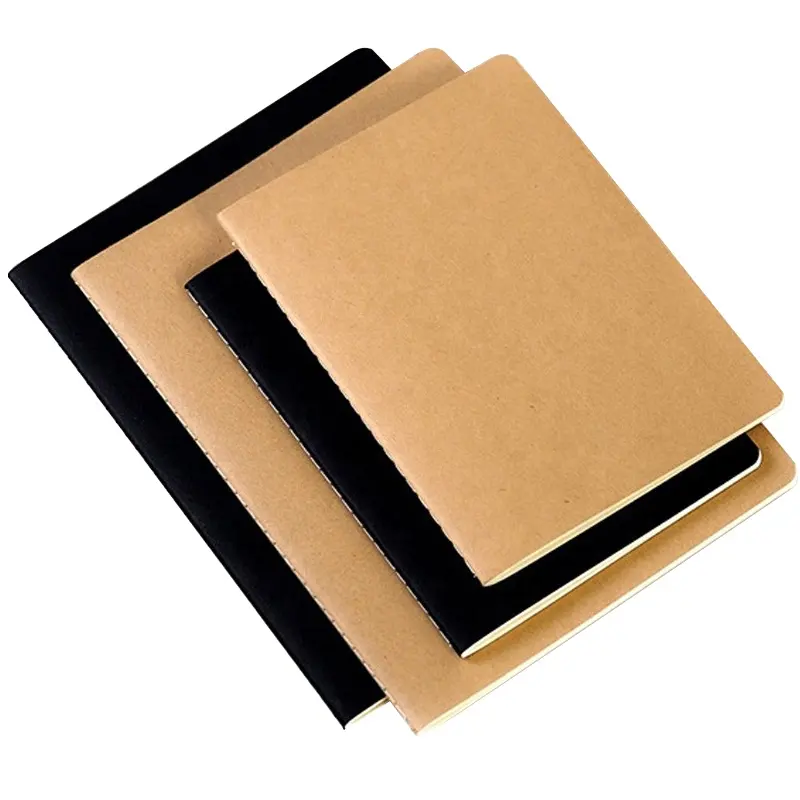
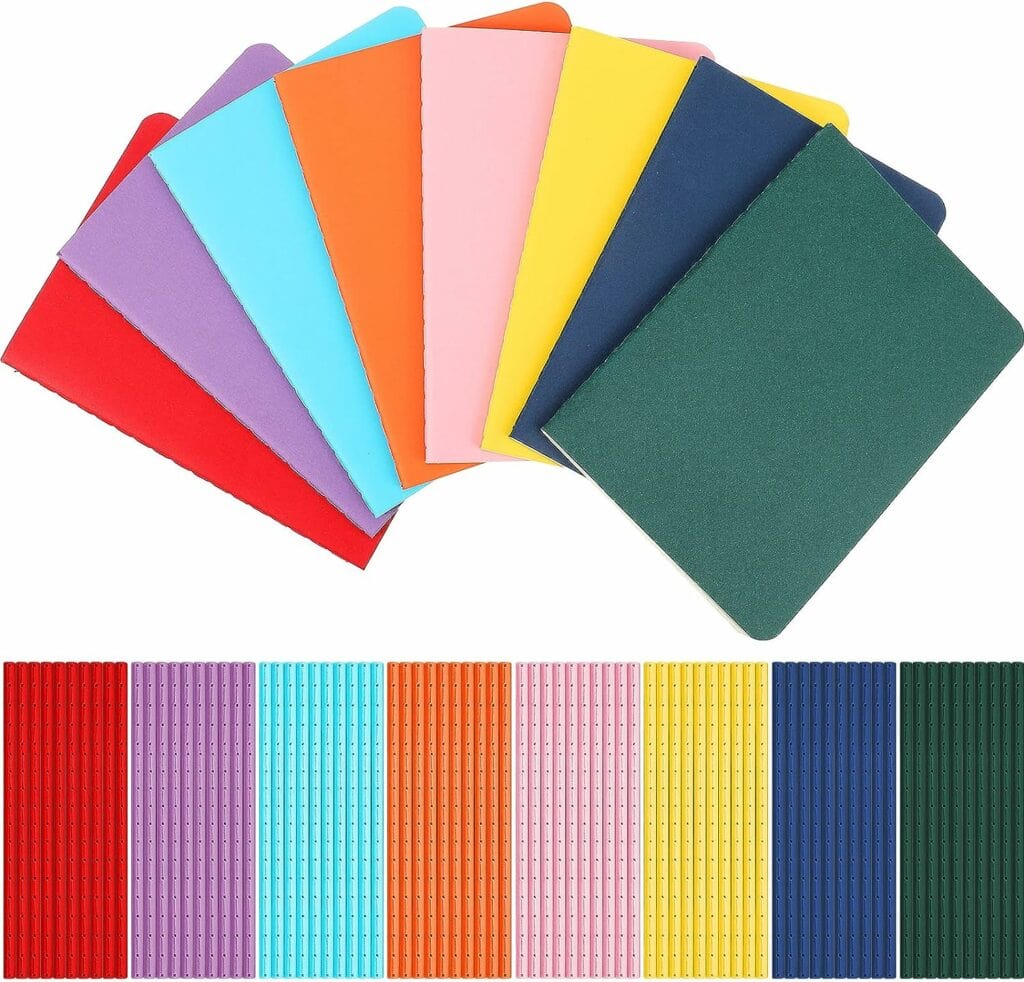
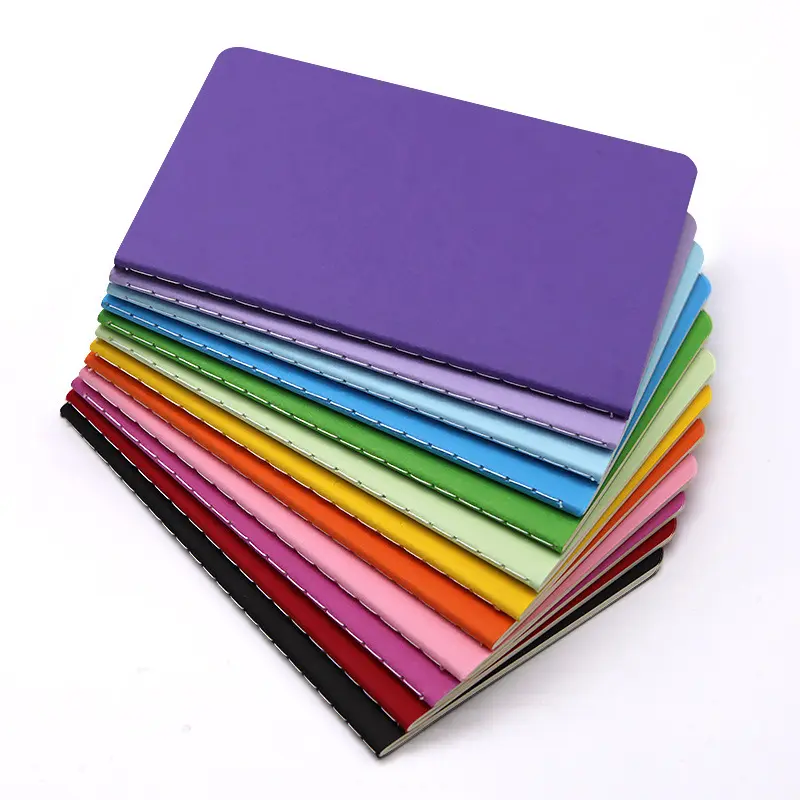
Common Use: Sewing Binding Notebooks are favored for their durability and longevity, making them suitable for a wide range of applications. They are often chosen for journals, diaries, special projects, and any use where quality and endurance are paramount.
Pros:
- Durability: Sewing binding creates a strong and long-lasting connection between pages, making the notebook highly durable.
- Lies Flat: The notebook easily lies flat when opened, providing a comfortable writing surface across the entire spread.
- Elegant Appearance: Sewn bindings add a touch of elegance and craftsmanship to the notebook’s aesthetic.
- Page Flexibility: Sewing allows for flexibility in page arrangement and the addition or removal of pages.
Cons:
- Complex Production: Sewing binding requires skilled craftsmanship and attention to detail, making production more intricate.
- Higher Cost: The labor-intensive process and quality materials used in sewing binding can lead to higher costs.
- Limited Personalization: Customization options may be more limited compared to other binding methods.
2. By Cover Material and Styles
The cover material and style of a notebook play a significant role in its overall look, feel, and functionality. The choice of cover material can impact the notebook’s durability, aesthetics, and suitability for different purposes. Let’s explore how types of notebooks can be categorized based on their cover materials and styles.
2.1 Hard Cover Notebook
A Hard Cover Notebook stands as a steadfast companion for those who seek durability and a touch of sophistication in their writing tools. With its sturdy exterior and structured design, this type of notebook offers a blend of resilience and elegance that appeals to a wide range of users.
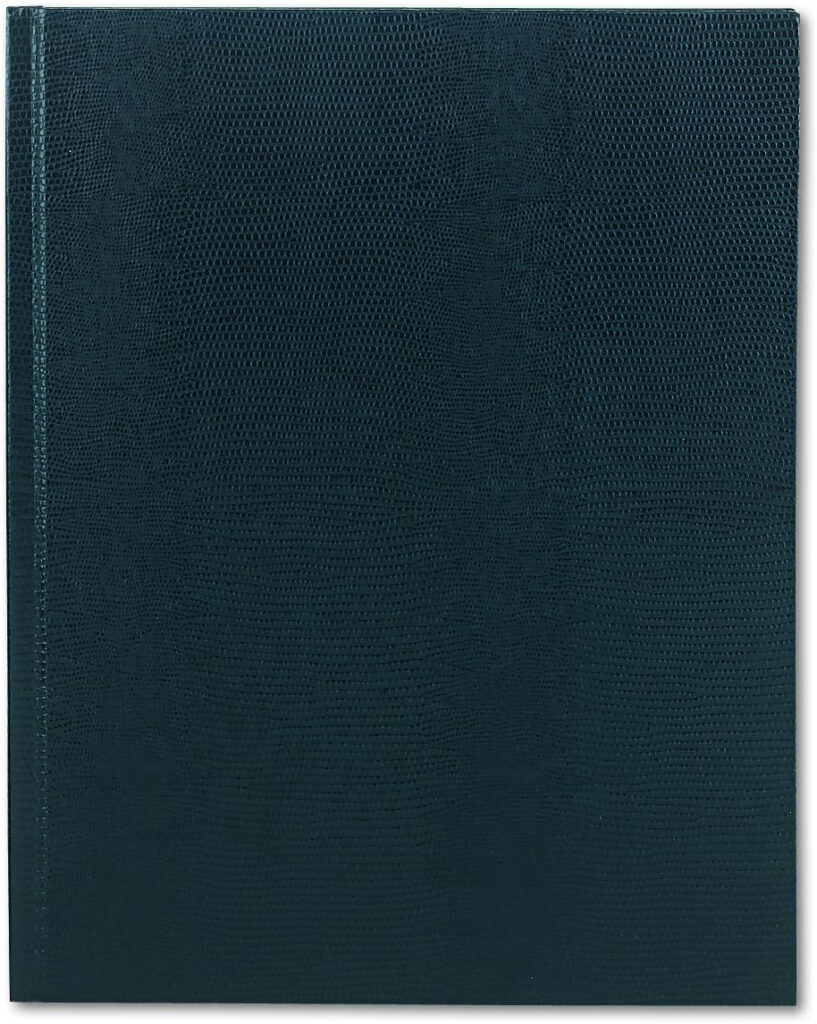
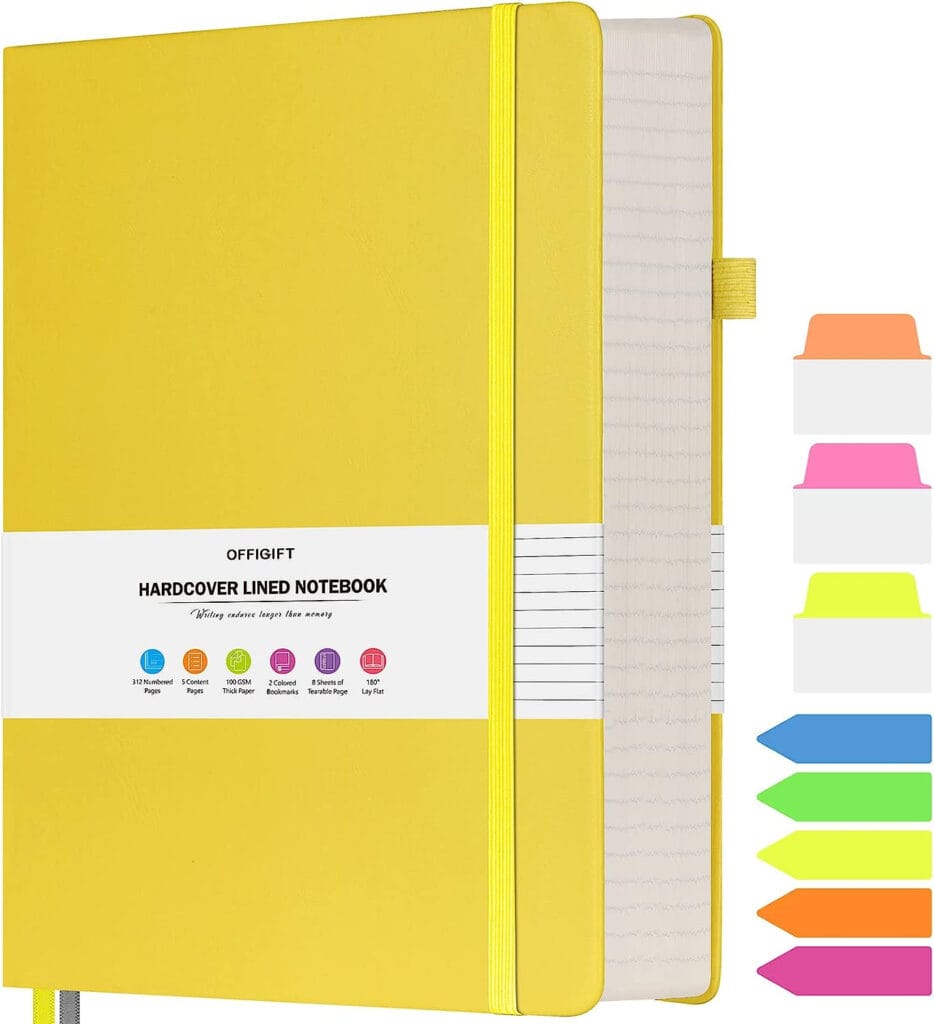
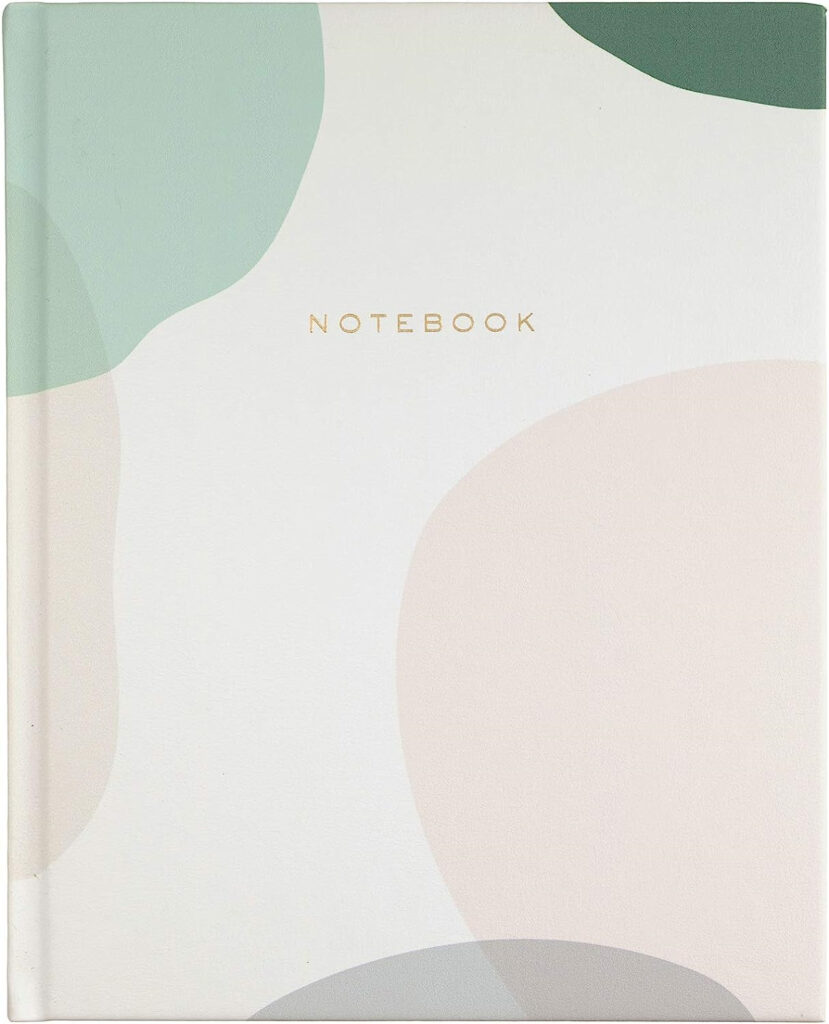
Common Use: Hard cover notebooks find favor among students, professionals, and creatives alike. They are often employed for note-taking, journaling, project planning, and various forms of creative expression. The robust cover provides added protection for the pages within, making it an ideal choice for preserving important thoughts and ideas. (Top 10 Hard Cover Notebooks In 2023)
Pros:
- Durability: The solid cover shields the pages from wear and tear, ensuring your writings endure over time.
- Professional Appearance: The sleek and polished exterior lends an air of professionalism to your notes and sketches.
- Longevity: The hardcover design enhances the notebook’s lifespan, allowing it to withstand frequent use.
- Stable Writing Surface: The rigid cover provides a stable base for writing, even when you’re on the move.
Cons:
- Weight: The sturdiness of the hardcover can add weight to the notebook, making it less convenient for carrying.
- Less Flexible: Compared to softcover options, hardcover notebooks may offer less flexibility in terms of portability.
2.2 Soft Cover Notebook
A Soft Cover Notebook embodies versatility and convenience, providing a lightweight and flexible writing companion that adapts to various needs. With its unassuming exterior, this type of notebook offers practicality and adaptability for individuals on the go.
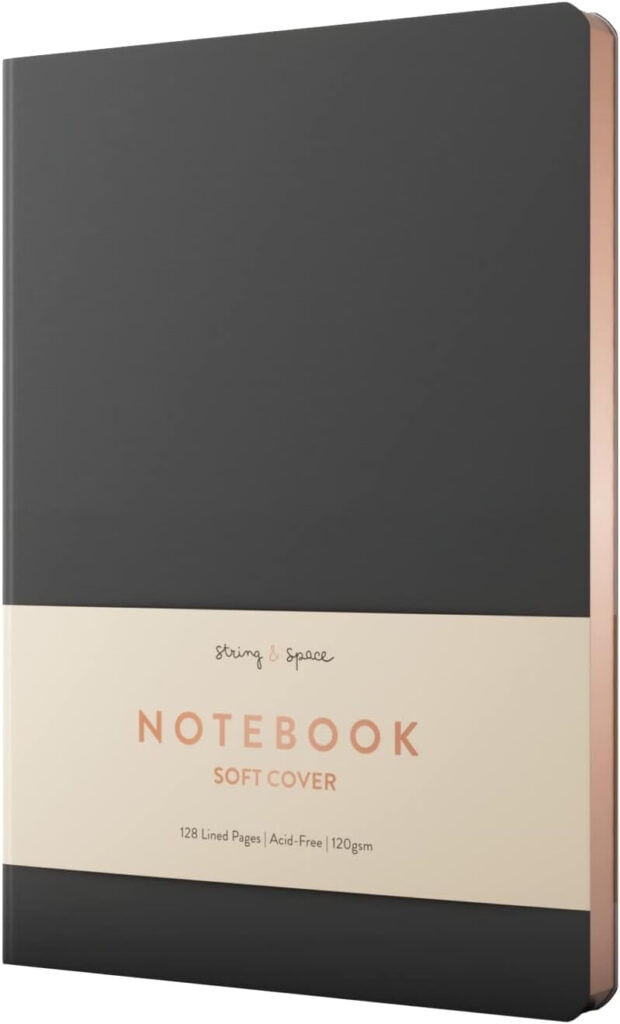
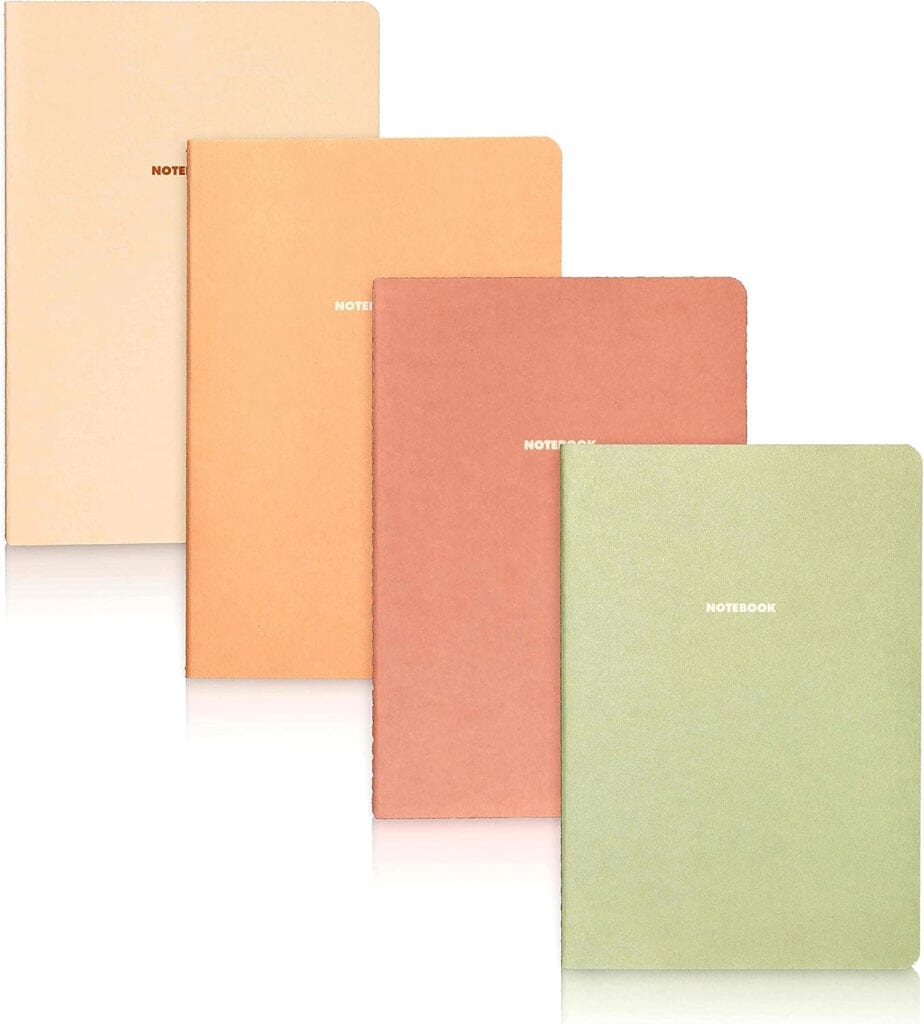
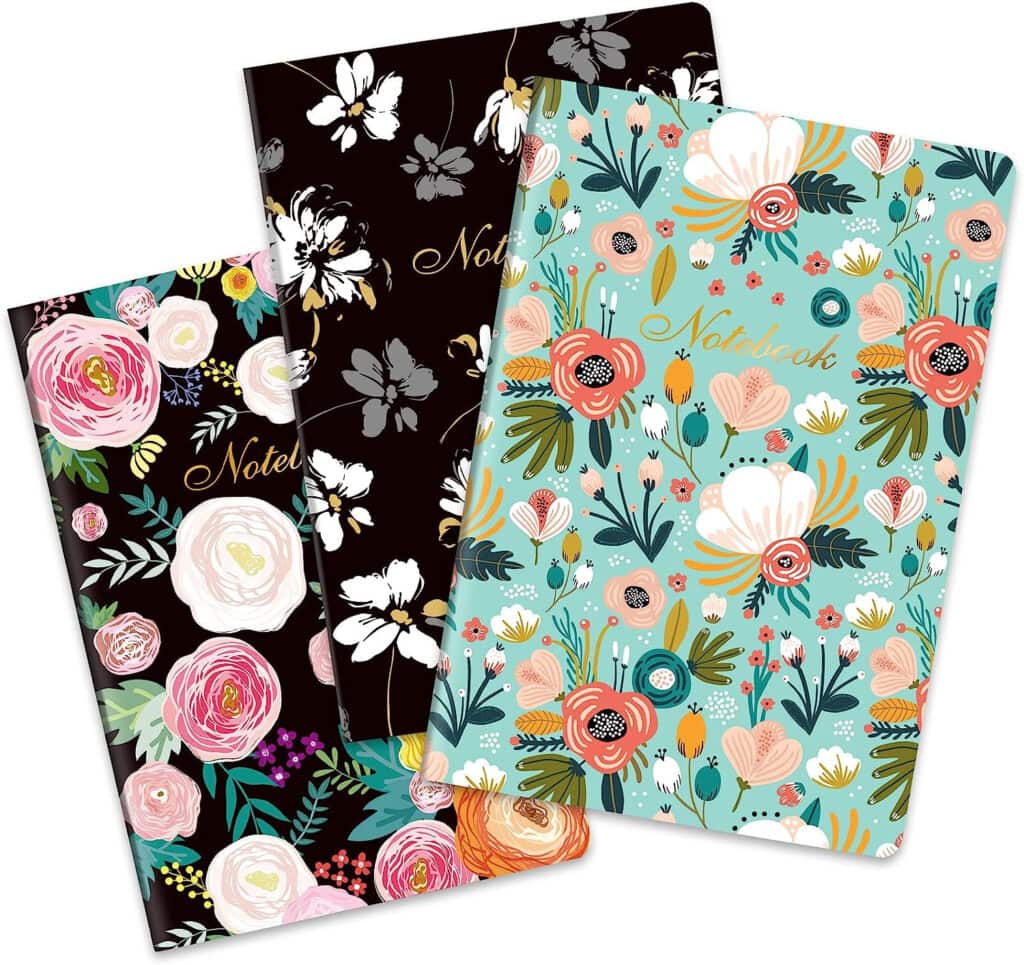
Common Use: Soft cover notebooks are favored by students, travelers, and anyone seeking a flexible writing solution. They excel as daily companions for note-taking, journaling, doodling, and more. The pliable cover allows the notebook to fit comfortably in bags or pockets, making it an ideal choice for those who require a writing tool that can keep up with their dynamic lifestyles.
Pros:
- Portability: The soft and lightweight cover ensures effortless transport and easy integration into daily routines.
- Adaptability: Soft Cover Notebooks are well-suited for various writing tasks, from quick notes to creative sketches.
- Easy to Store: The flexible cover facilitates stacking and storing multiple notebooks with ease.
Cons:
- Less Protection: The soft cover design may offer less protection to the pages compared to hardcover options.
- Durability: Over time, the cover may show signs of wear, potentially affecting its overall appearance.
2.3 Leather Notebook
A Leather Notebook exudes timeless elegance and durability, making it a cherished writing instrument that stands the test of time. With its refined exterior and luxurious feel, this type of notebook adds a touch of sophistication to the act of putting pen to paper.
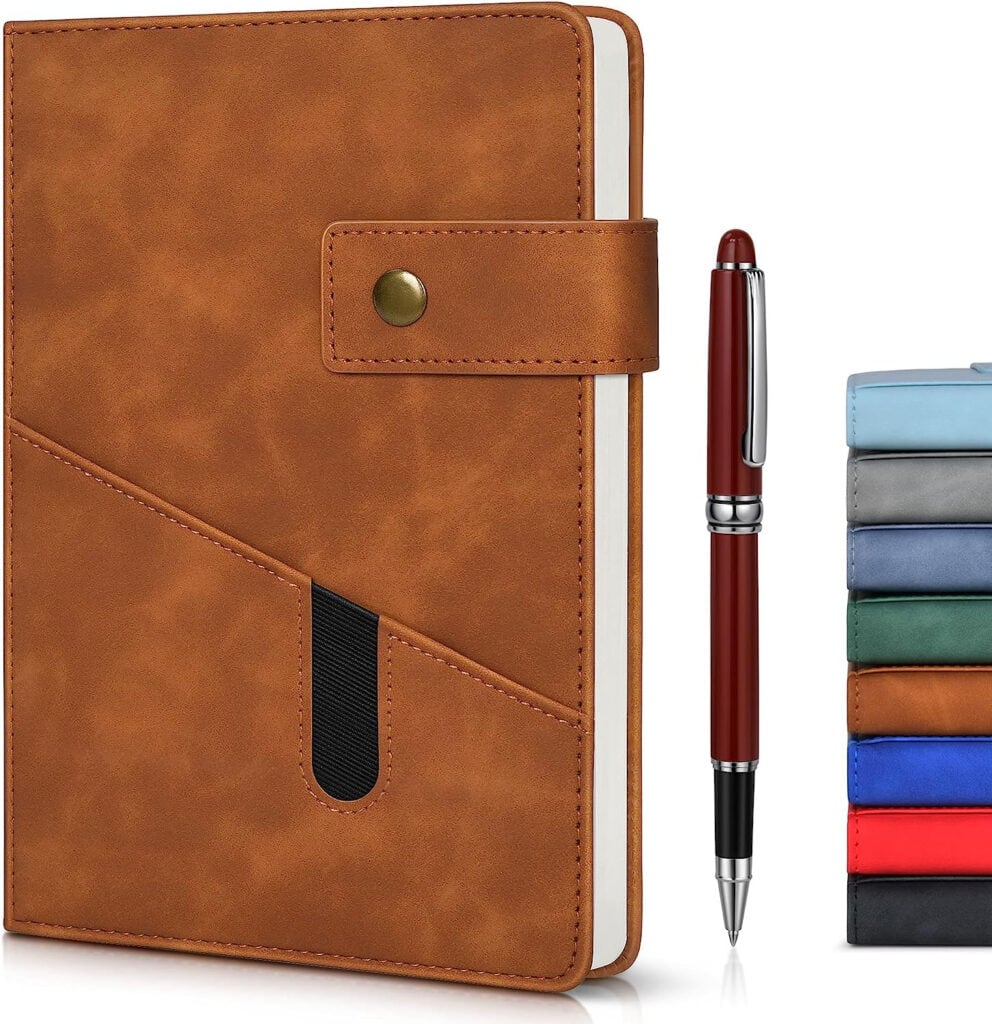

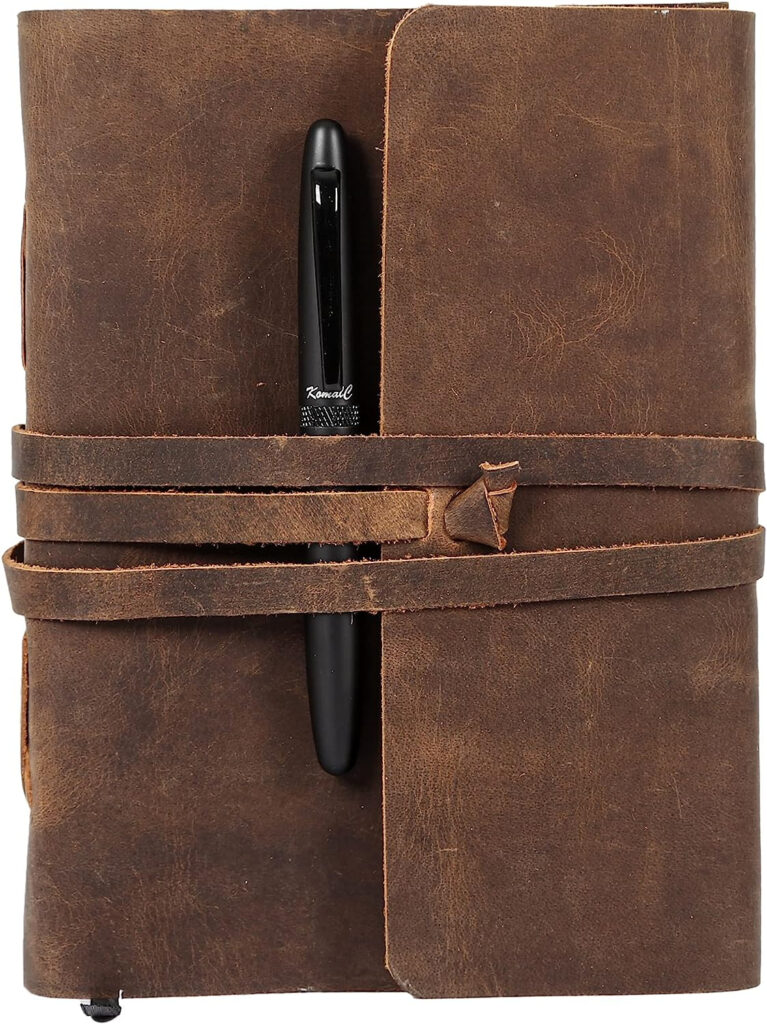
Common Use: Leather notebooks are favored by professionals, executives, and individuals who appreciate fine craftsmanship. They are often chosen for note-taking, journaling, creative writing, and gifting. The supple and tactile nature of the leather cover creates an inviting space for ideas to flow, making it an ideal canvas for capturing thoughts and memories.
Pros:
- Luxurious Aesthetics: The leather cover exudes a sense of luxury and prestige, making it a statement piece.
- Durability: Leather is known for its longevity and ability to age gracefully, preserving your writings for years.
- Personalization: Leather Notebooks often allow for customization, adding a personal touch to your writing tool.
Cons:
- Higher Cost: The premium material and craftsmanship of leather notebooks often come with a higher price tag.
- Maintenance: Leather requires occasional care to maintain its appearance and longevity.
- Weight: Depending on the size and thickness, leather notebooks may be heavier compared to other options.
2.4 Cute Notebooks
Cute notebooks are whimsical and visually appealing writing companions that add a touch of charm and personality to your note-taking and creative endeavors. With their delightful designs and playful aesthetics, they infuse a sense of joy and inspiration into your writing experience.
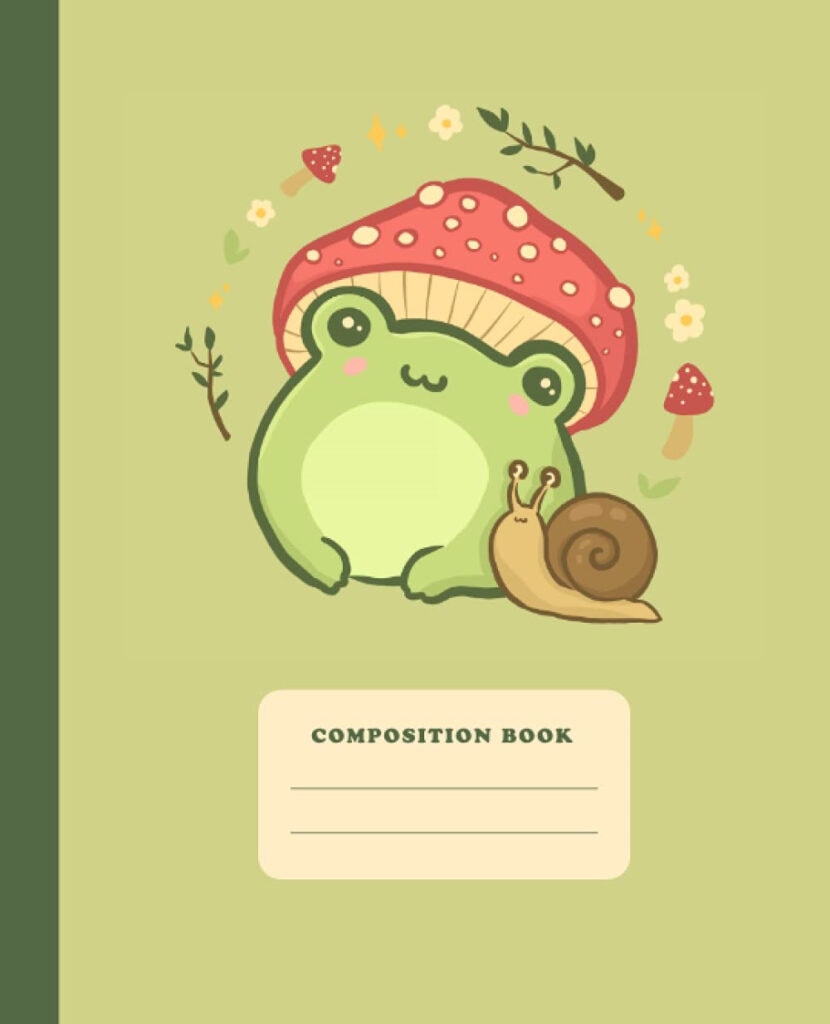
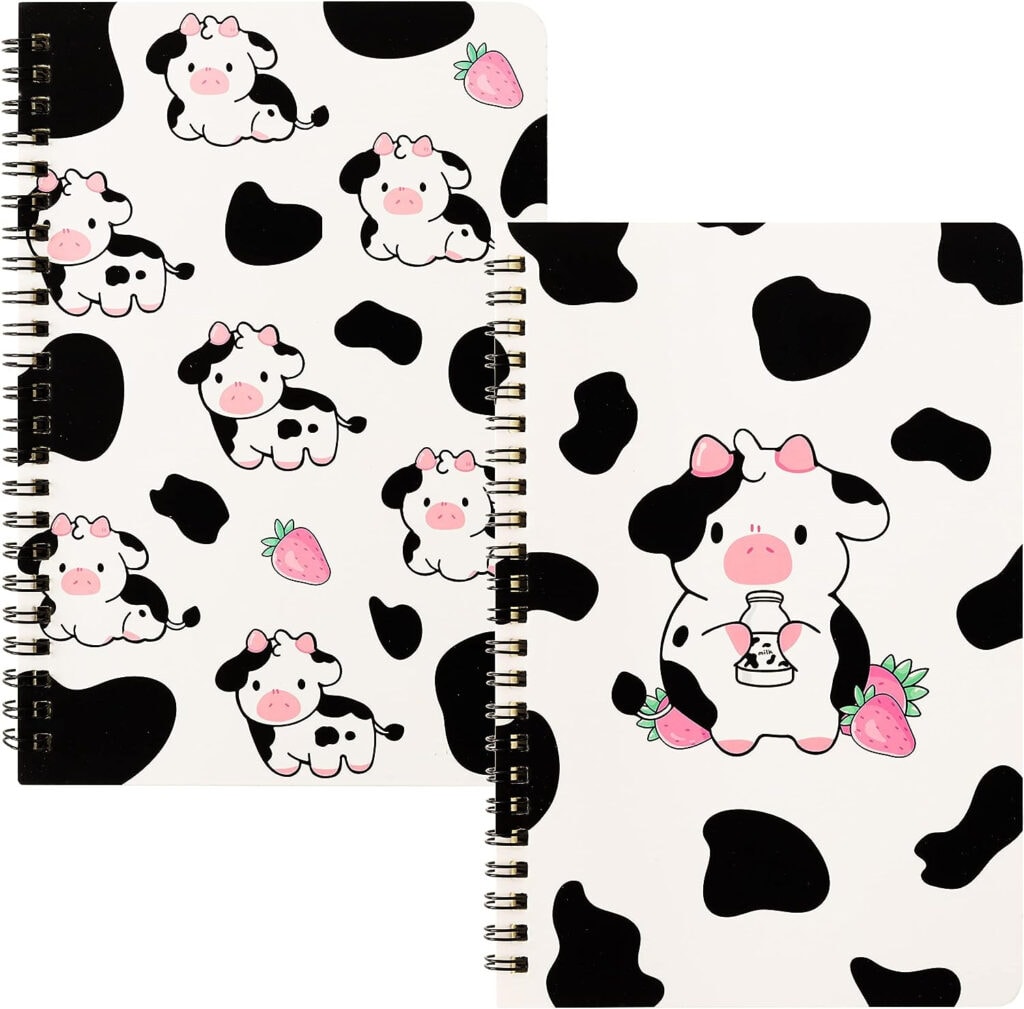
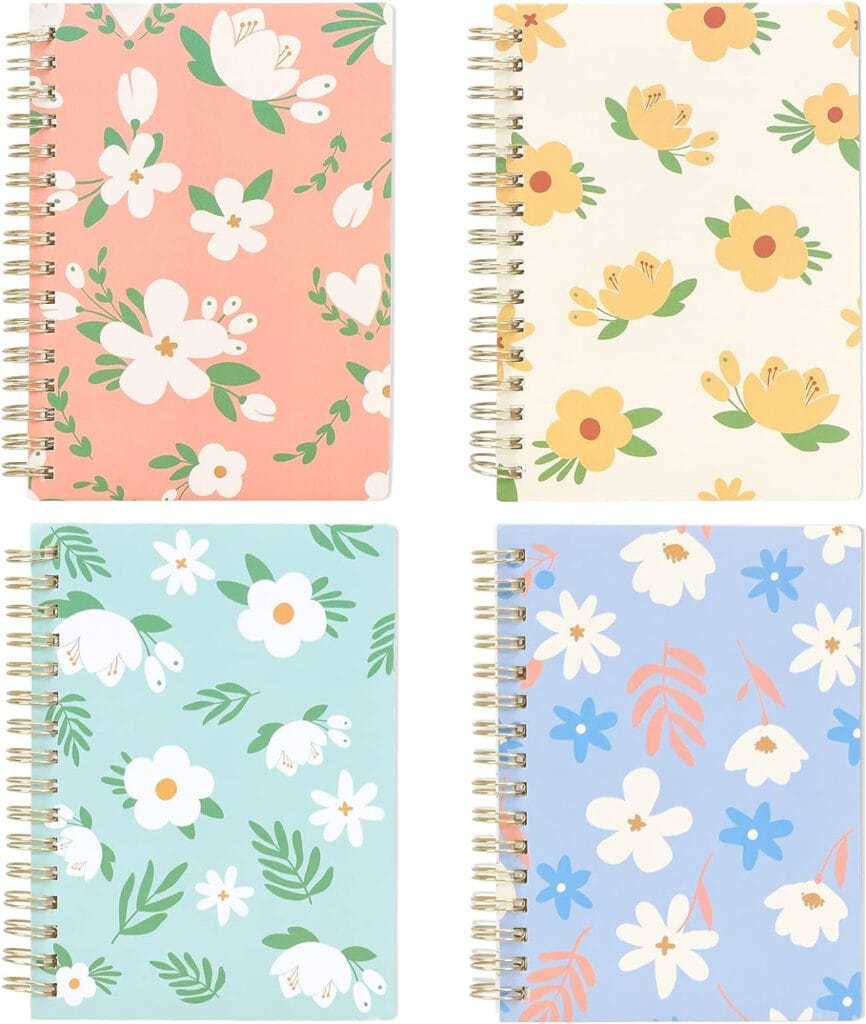
Common Use: Cute notebooks are adored by individuals of all ages who appreciate vibrant and adorable designs. They are often used for a variety of purposes, including journaling, doodling, writing letters, and even simple task lists. Cute Notebooks cater to those who seek to infuse a bit of fun and positivity into their everyday writing routine.
Pros:
- Visual Delight: Cute Notebooks maybe feature eye-catching designs, patterns, and illustrations that spark creativity.
- Mood Elevation: The whimsical aesthetics can uplift your mood and make the act of writing more enjoyable.
- Personal Expression: Cute Notebooks allow you to showcase your personality and style through your stationery.
Cons:
- Distraction Potential: The vibrant designs might occasionally divert focus from the content itself.
- Limited Professionalism: Depending on the context, cute designs may not be suitable for all professional settings.
2.5 Marble Notebook
A marble notebook exudes elegance and sophistication, featuring a distinct marble-like pattern on its cover. With its luxurious appearance and timeless design, it offers a touch of refined aesthetics to your writing and creative endeavors.
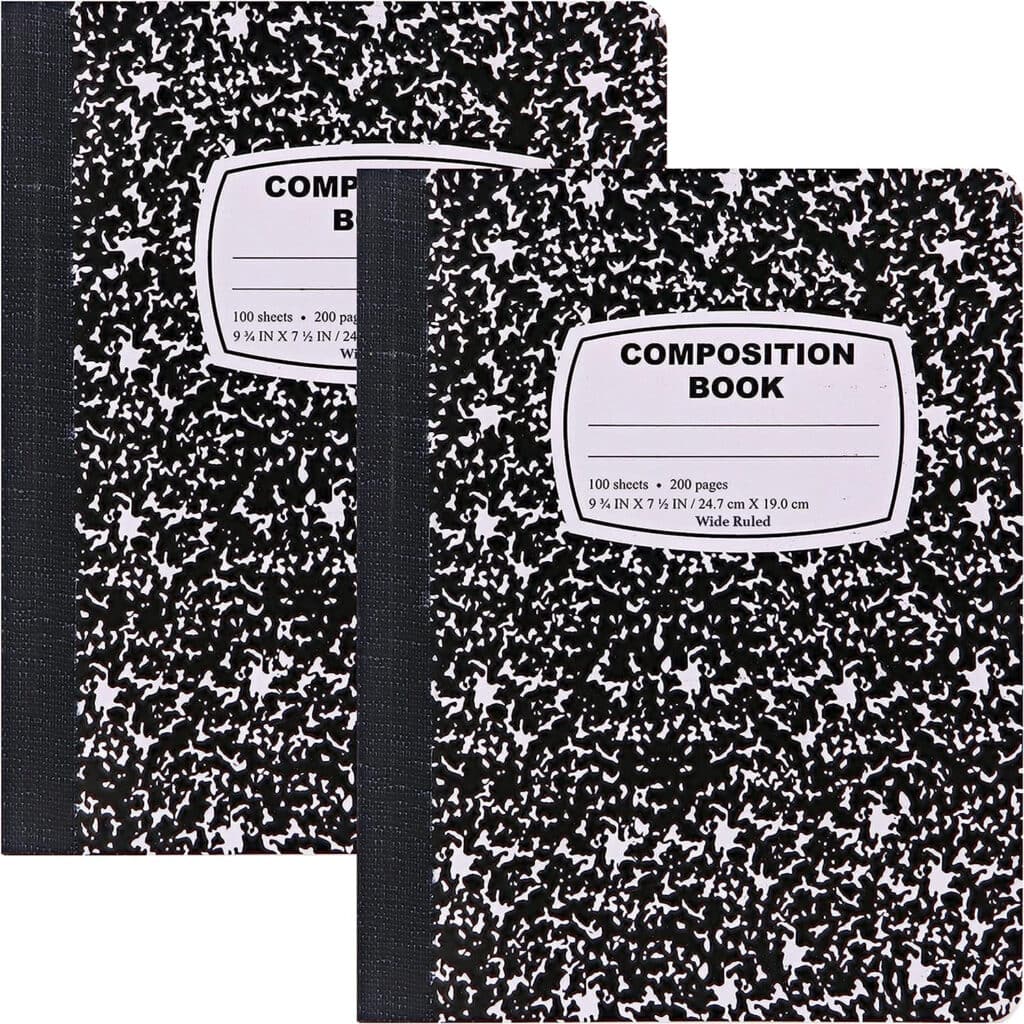
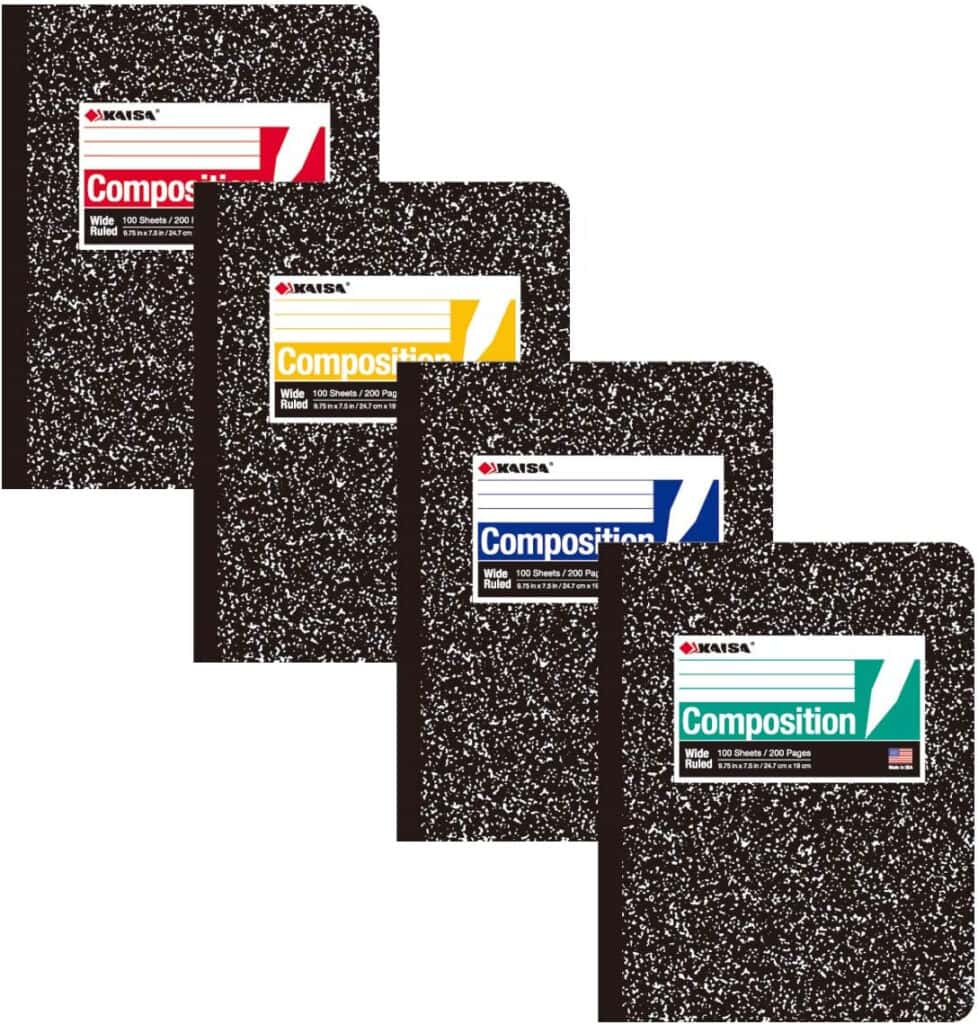
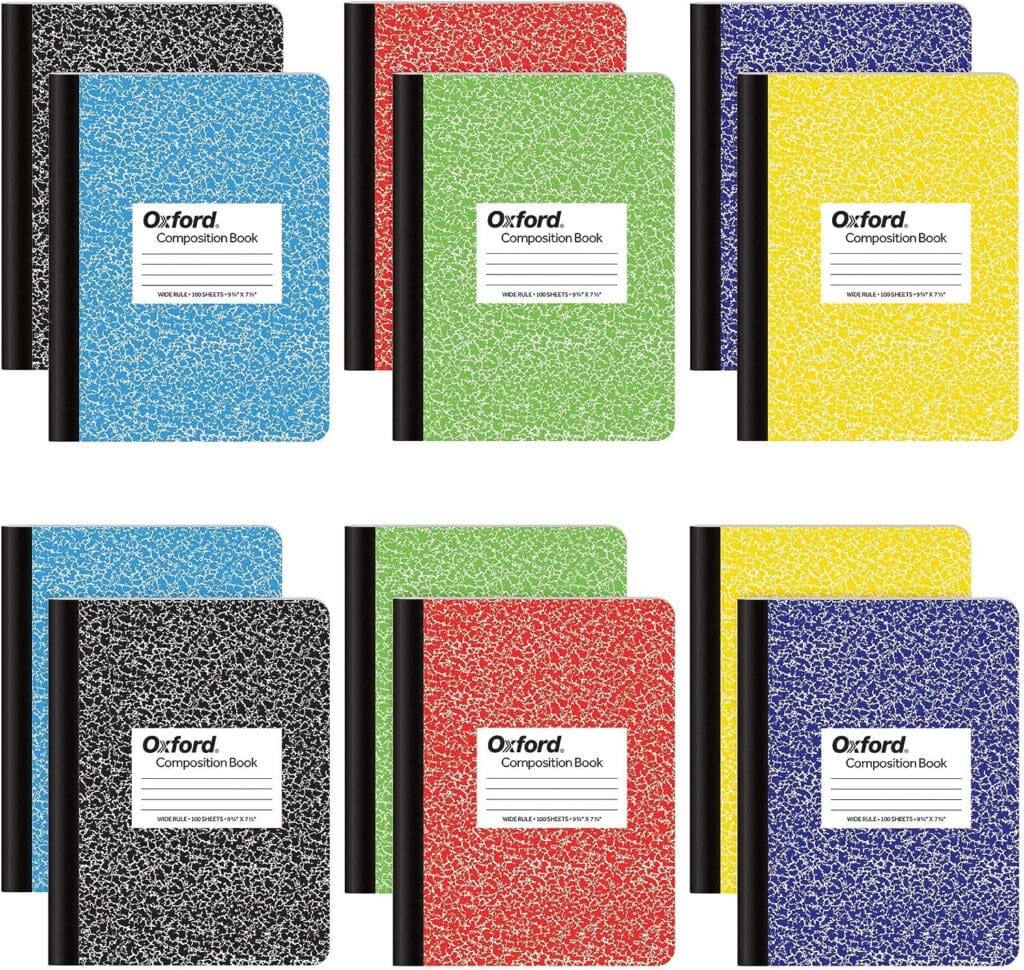
Common Use: Marble notebooks are favored by individuals who appreciate opulent and stylish stationery. They are often used for a variety of purposes, including note-taking, journaling, sketching, and gift-giving. Marble Notebooks are particularly popular among professionals, creatives, and those who seek a balance between functionality and aesthetics. (All There Is To Know About Marble Composition Notebooks)
Pros:
- Aesthetic Appeal: The marble pattern adds a sense of luxury and visual intrigue to your notebook.
- Elegance: The sophisticated design makes Marble Notebooks suitable for both personal and professional use.
- Timeless Quality: The classic marble pattern remains stylish and relevant across various trends.
Cons:
- Limited Texture: The cover might lack the tactile feel of genuine marble.
3. By Inner Page
The design and layout of the inner pages of a notebook can significantly influence its usability and suitability for specific tasks. Different rulings, paper types, and formats cater to various writing styles, preferences, and creative needs. Let’s delve into how types of notebooks can be classified based on their inner pages.
3.1 French Notebook
The French Notebook was introduced by Jean-Alexandre Seyès in the late 19th century. Its impact is felt not only in classrooms but also in creative spaces, promoting refined penmanship and fostering artistic expression. With its distinctive grid pattern and global recognition, the French Notebook continues to inspire individuals to embrace the beauty of handwritten words and creative endeavors.
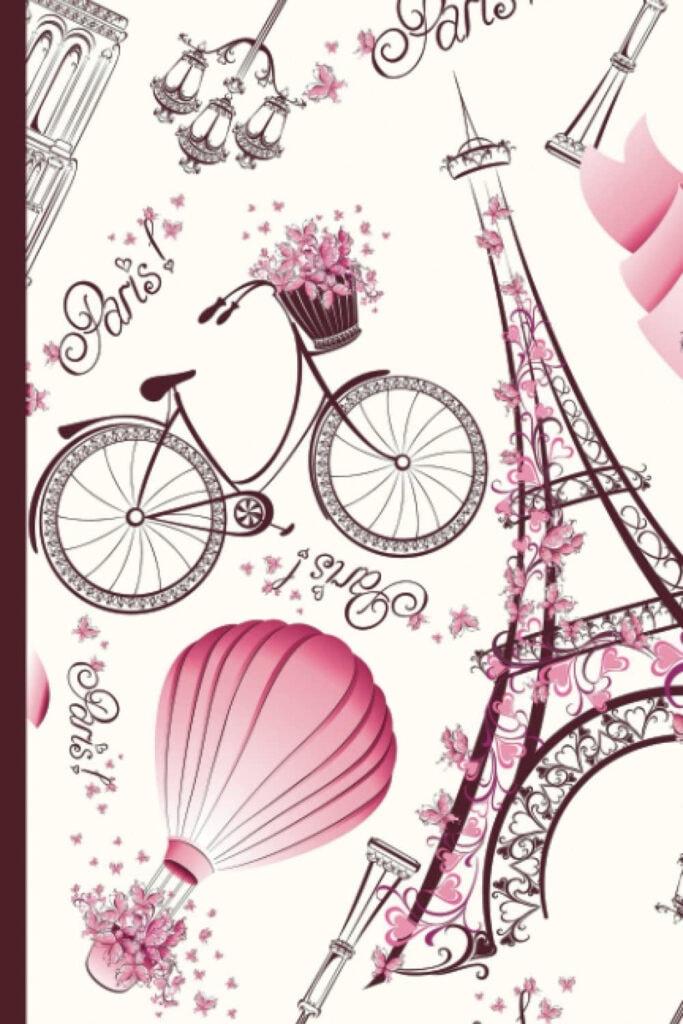
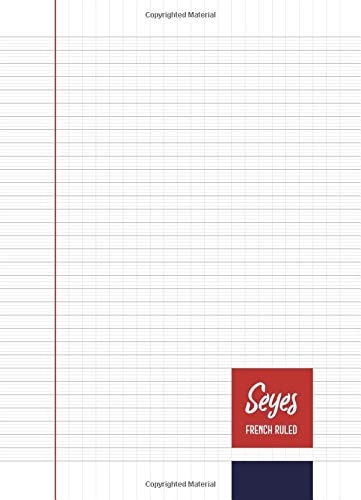

Common Use: The French notebook is a staple in classrooms and creative spaces. Its specialized grid pattern, blending vertical and horizontal lines with thinner lines bordered by bold ones, aids students in developing consistent letter size and alignment. This notebook is instrumental in honing handwriting skills and fostering artistic endeavors. (French Notebook: The Most Comprehensive Guide)
Pros:
- Precise Handwriting: The grid pattern ensures uniform letter proportions, enhancing the art of elegant penmanship.
- Versatile Creativity: The structured layout encourages both neat writing and imaginative drawings.
- Global Recognition: Its unique design has gained popularity beyond France.
Cons:
- Limited Flexibility: The specialized grid might not suit all writing styles or preferences.
- Availability: Outside of educational contexts, finding authentic French Notebooks could be challenging.
3.2 Dotted Notebook
A dotted notebook, featuring a subtle yet strategic arrangement of dot grids, offers a harmonious blend of structure and creative freedom. Its unobtrusive dot pattern provides a versatile canvas for various forms of writing, sketching, and planning
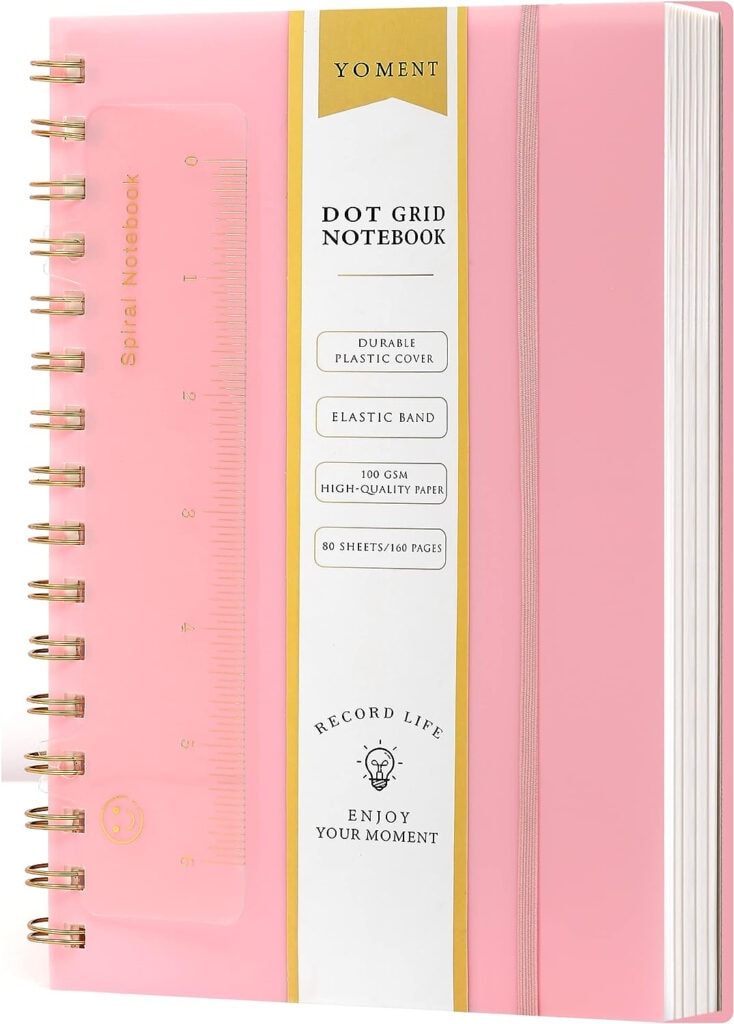
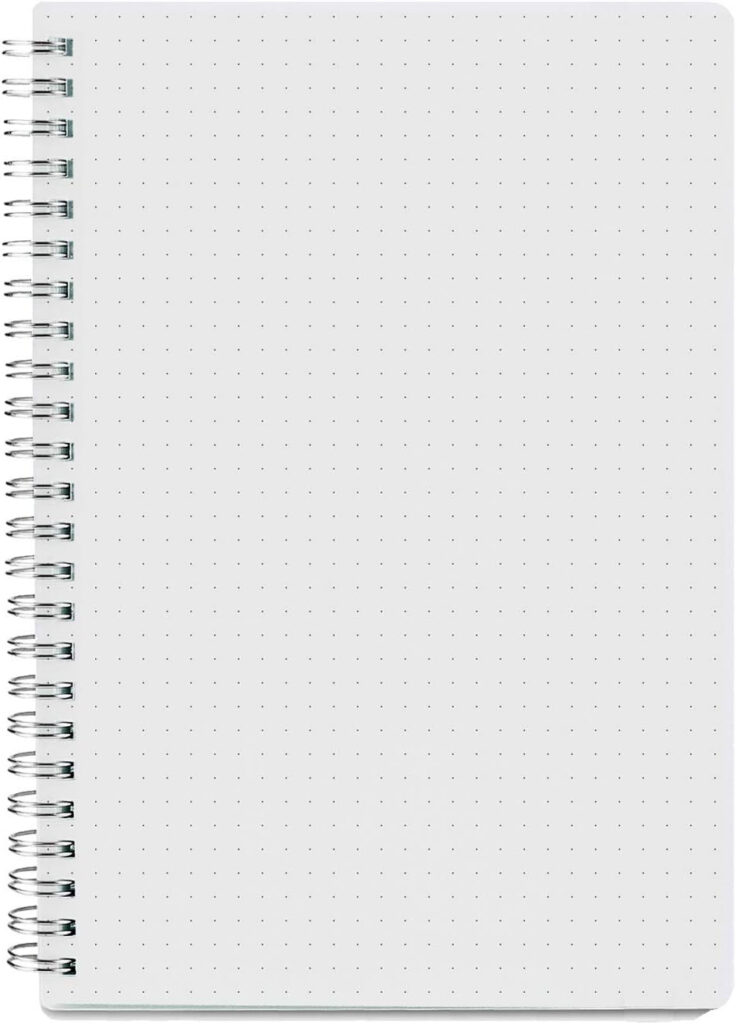
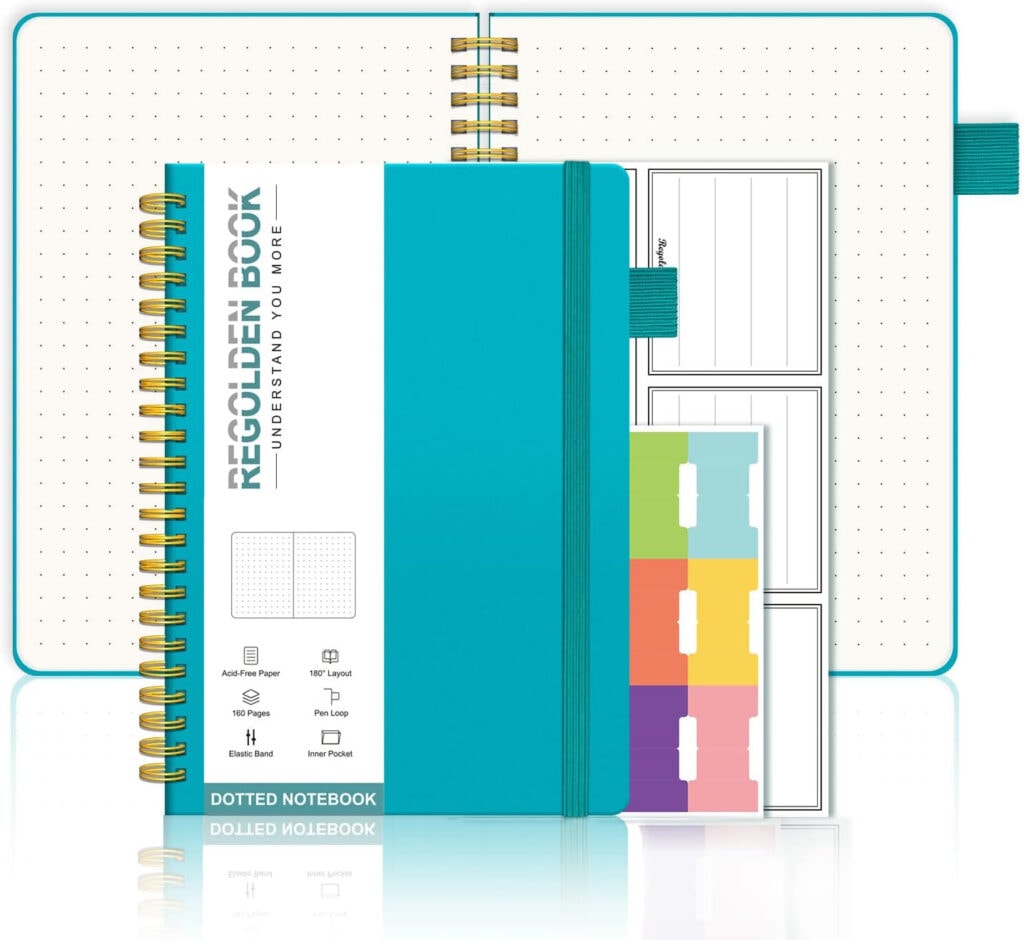
Common Use: Dotted notebooks are favored by bullet journal enthusiasts, artists, writers, and individuals who seek a balance between organized layouts and open space. The dot grids serve as discreet guides for creating to-do lists, calendars, intricate drawings, and even elaborate calligraphy. They are a go-to choice for those who want the benefits of lined and blank notebooks combined.
Pros:
- Versatile Grid: The dot pattern offers flexibility, allowing for precise alignment and creative layouts.
- Structured Creativity: Dotted Notebooks provide guidance for neat designs, while leaving room for artistic expression.
- Customizable Layouts: The dots can be connected or ignored, offering the freedom to create personalized structures.
Cons:
- Subtle Guide: Some users might find the dots less prominent compared to traditional ruled or grid patterns.
- Ink Bleeding: Depending on paper quality and ink type, dots might bleed through or show on the opposite side of the page.
- Learning Curve: It might take a bit of practice to achieve perfectly straight lines and uniform designs.
3.3 Lined Notebook
A lined notebook, characterized by its uniform rows of horizontal lines, provides a straightforward and organized platform for writing, note-taking, and daily reflections. With its simple yet effective layout, it offers a dependable space for capturing thoughts and ideas.
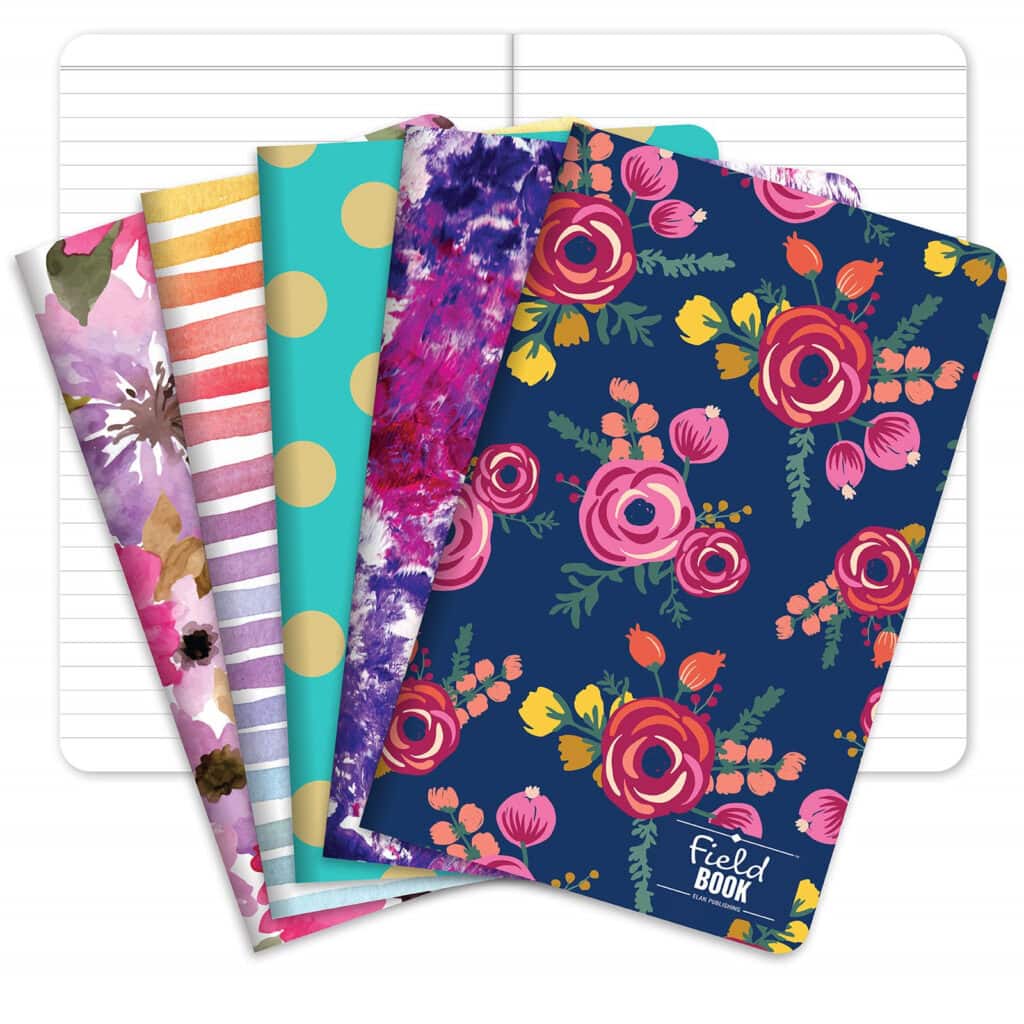
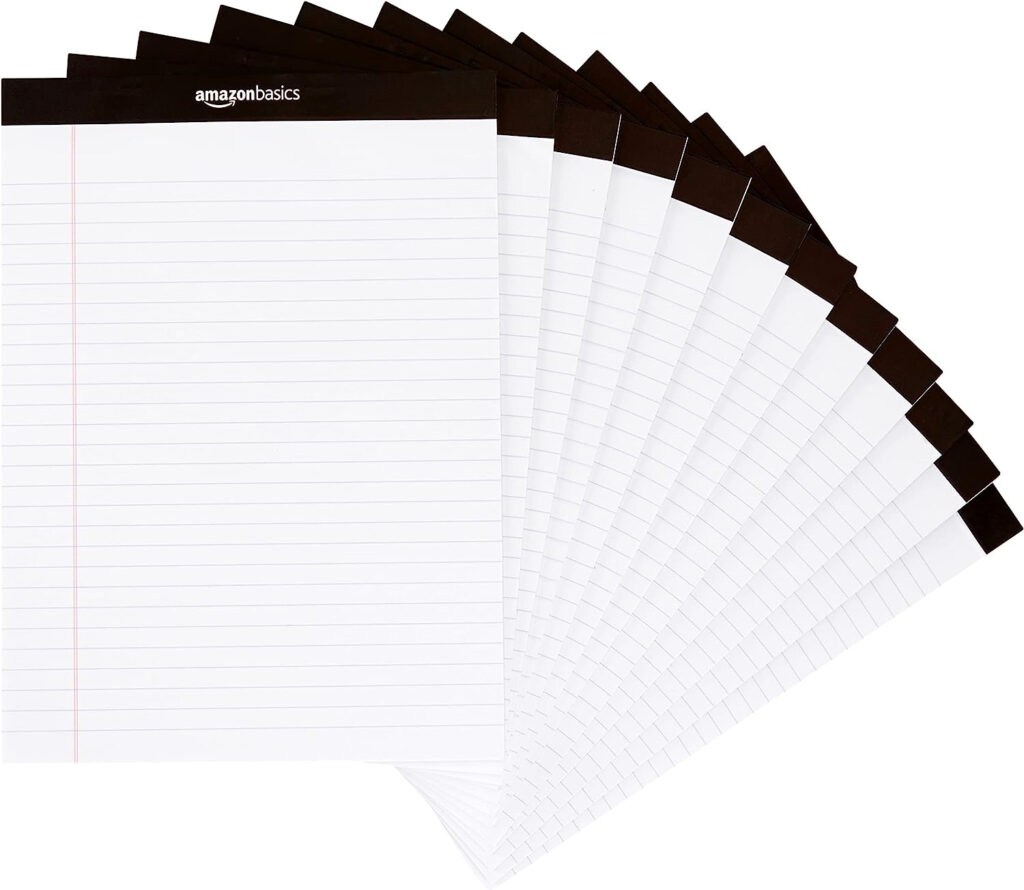
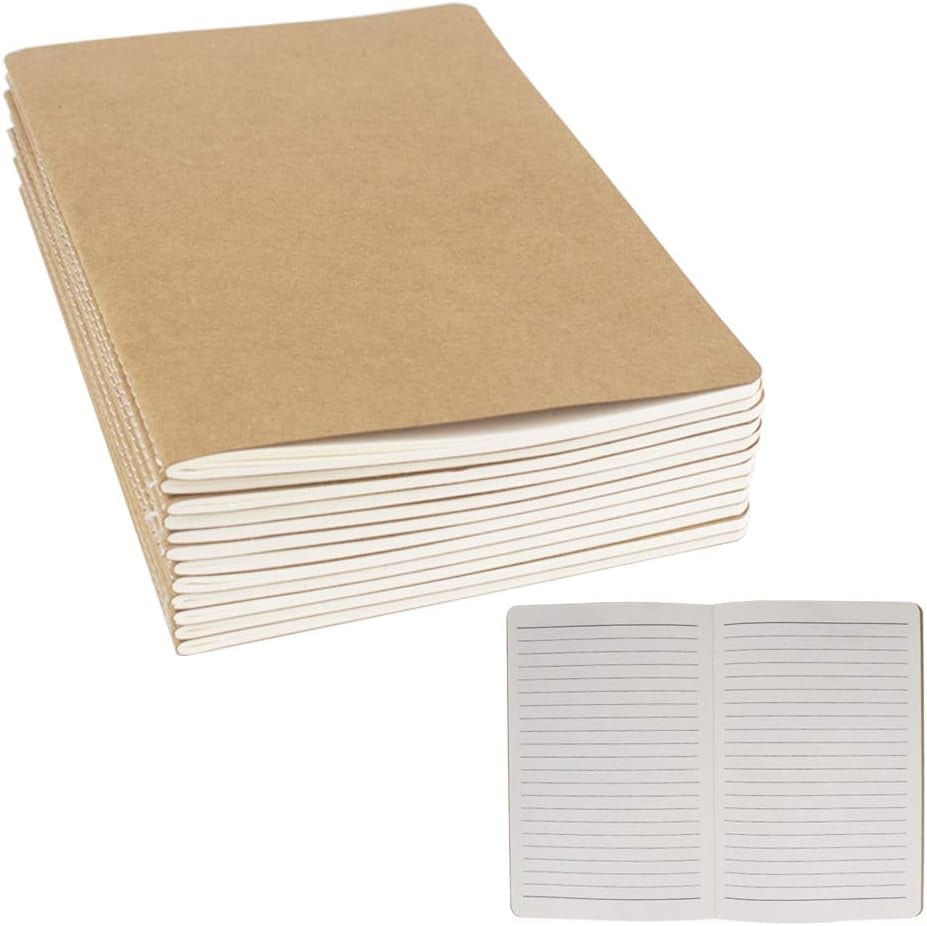
Common Use: A lined notebook is a reliable tool that fosters clear and organized writing. Whether used for academic pursuits, professional tasks, or personal reflections, its structured layout encourages focused note-taking and efficient information organization. They are an ideal choice for jotting down lecture notes, drafting essays, and recording thoughts.
Pros:
- Structured Writing: The lines offer guidance for maintaining even spacing and legible handwriting.
- Efficiency: Lined Notebooks are efficient for linear writing tasks, allowing for quick note-taking and organization.
- Neatness: The consistent lines help keep writing neat and aligned.
Cons:
- Limited Flexibility: The lines may constrain artistic expression or unconventional writing styles.
- Less Versatile for Sketching: The structured lines might not be suitable for elaborate drawings or detailed sketches.
3.4 Grid Notebook
A grid notebook, characterized by its organized grid pattern, serves as a versatile tool that strikes a balance between structure and creativity. With its uniform layout of horizontal and vertical lines, it offers a unique canvas for various writing and design endeavors.
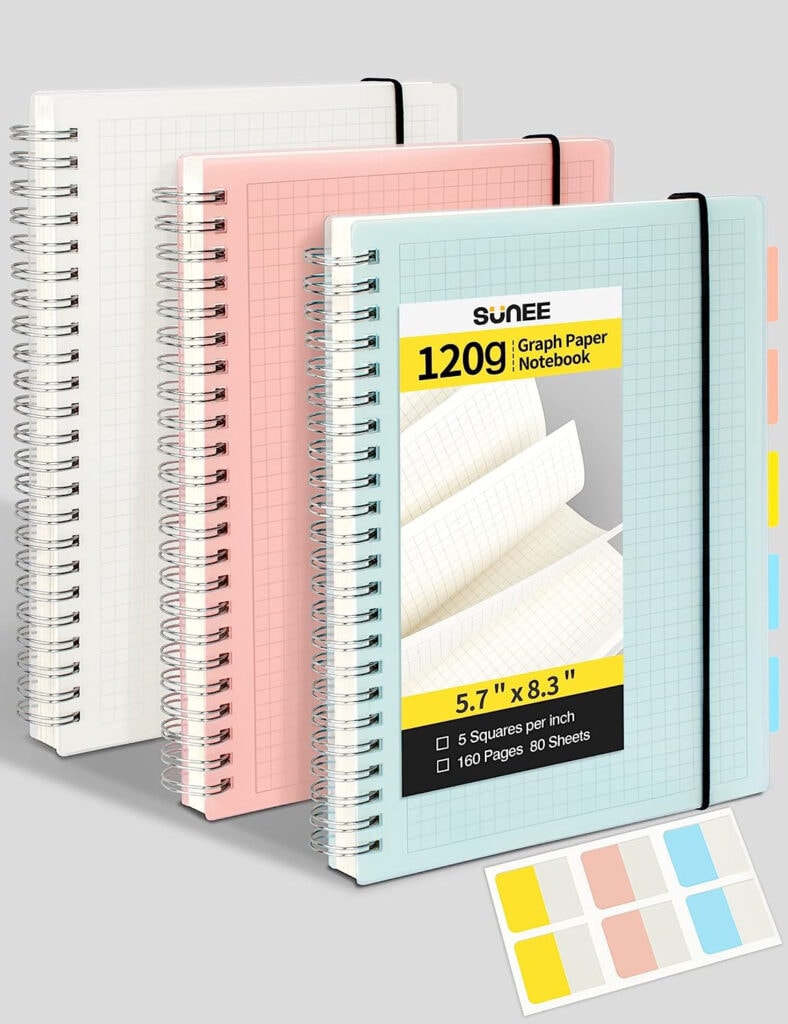
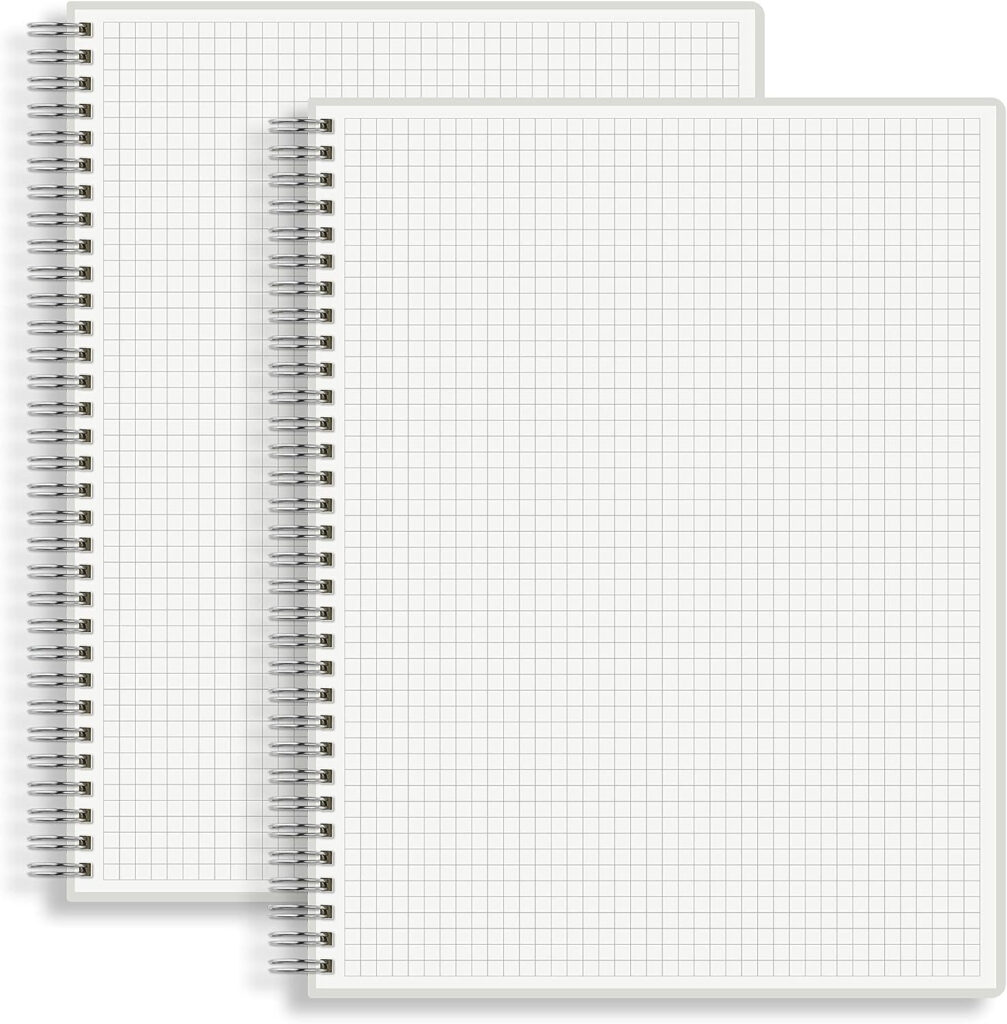
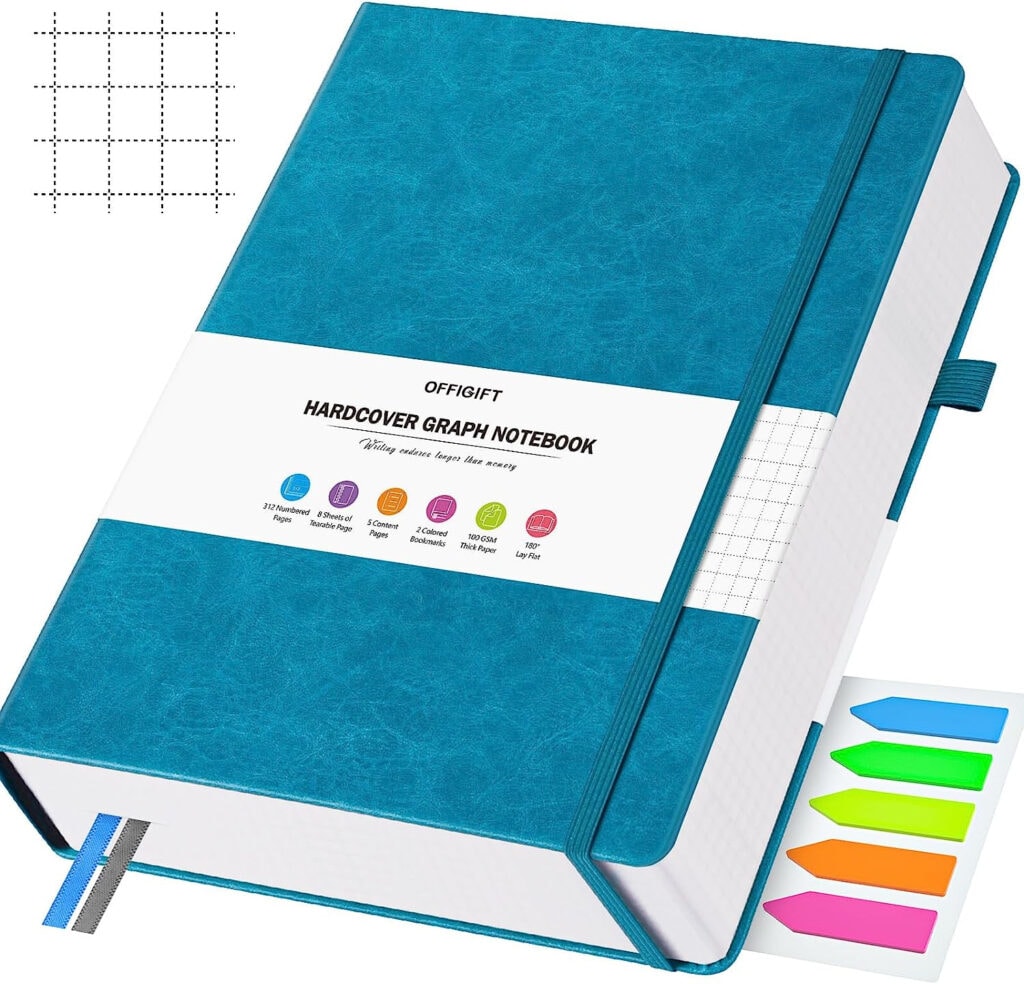
Common Use: Grid notebooks find favor among designers, architects, students, and individuals who appreciate a structured format for both writing and sketching. The grid pattern provides guidance for neat handwriting, precise diagrams, charts, and technical drawings. It’s a preferred choice for those who seek the benefits of lined and blank notebooks combined.
Pros:
- Structured Layout: The grid pattern offers a consistent framework for organizing notes, sketches, and diagrams.
- Versatility: Suitable for a range of tasks, from mathematical calculations and design drafts to creative doodles.
- Neatness: The grid lines facilitate tidy handwriting and ensure even spacing between elements.
- Graphing and Diagramming: Grid Notebooks are ideal for creating precise graphs, charts, and intricate designs.
Cons:
- Visual Distraction: Some individuals may find the grid pattern distracting when used for purely writing purposes.
- Creativity Balance: While it provides structure, the grid pattern might limit the freedom of completely blank pages.
The above are several common types of notebooks with different inner pages. If you want to know more, please click here: Notebook Inner Page: The Ultimate FAQ Guide.
4. By Purpose
Notebooks come in a wide variety of styles and formats, each tailored to serve different purposes and activities. The purpose for which a notebook is intended can greatly influence its design, layout, and features. Let’s explore how types of notebooks can be categorized based on their intended purposes.
4.1 Composition Notebook
A Composition Notebook is a classic and timeless writing tool cherished for its simplicity and utility. Recognizable by its marbled cover and sewn or glued pages, this notebook is a staple in academic and creative settings. It embodies a sense of tradition and nostalgia, often associated with school days and the act of putting thoughts onto paper.
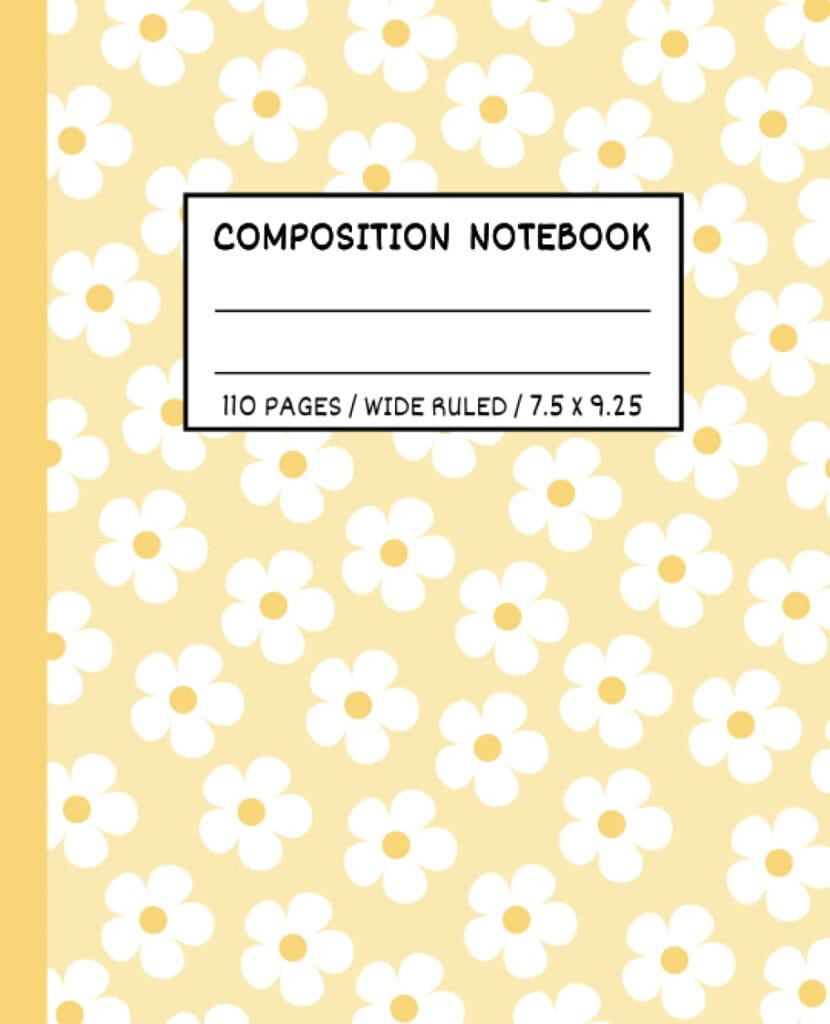

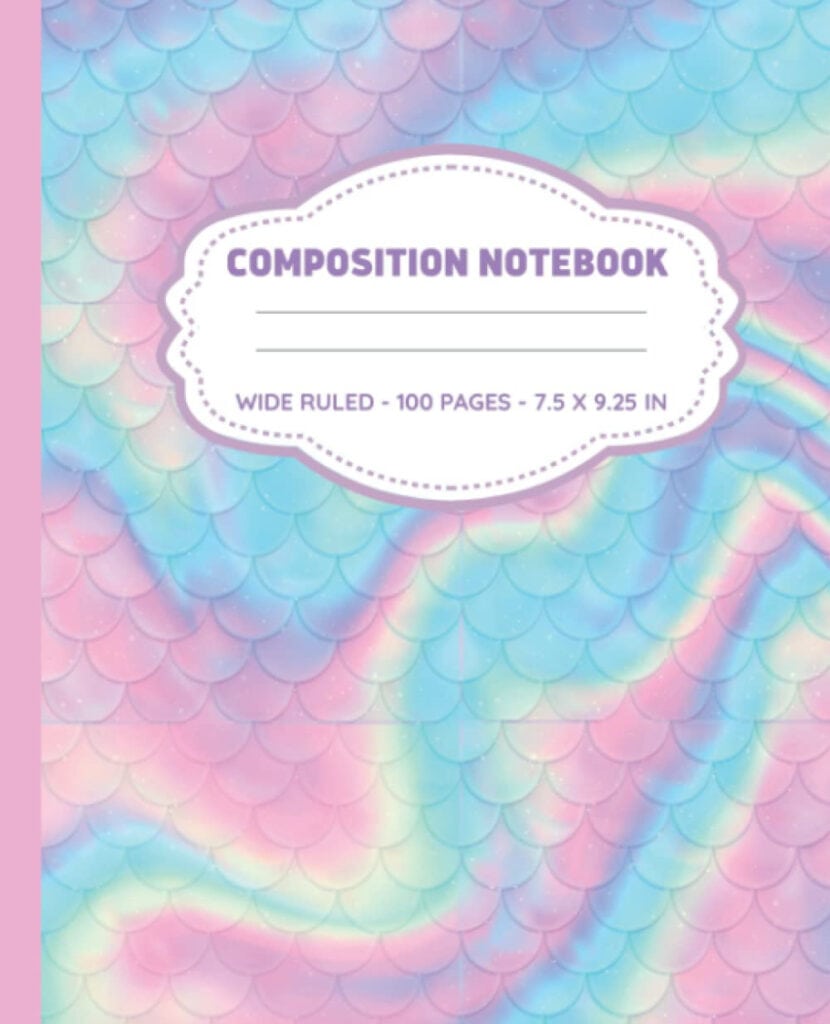
Common Use: Composition notebooks are favored by students, writers, and individuals who appreciate a structured and organized writing experience. They are well-suited for taking notes, journaling, brainstorming, and even doodling. The sturdy binding and consistent format encourages users to maintain neat and orderly entries.
Pros:
- Structured Format: The ruled lines and uniform page layout provide guidance for tidy writing and drawing.
- Durable Cover: The robust cover, often adorned with a marbled design, offers protection to the pages inside.
- Versatility: Suitable for a wide range of writing tasks, from note-taking to creative writing.
- Nostalgic Appeal: This evokes a sense of nostalgia and tradition, making it a cherished writing companion.
Cons:
- Limited Customization: Compared to more modern notebooks, the composition notebook may lack customizable features.
- Bulkiness: Depending on the number of pages, these notebooks can become relatively thick and bulky.
- Less Portable: The rigid binding and weight may be less convenient for on-the-go use.
4.2 Sketchbook
A Sketchbook is more than just a collection of blank pages; it’s a haven for artistic inspiration and growth. From rough initial concepts to refined masterpieces, a sketchbook is a trusted companion on an artist’s journey. It captures moments of inspiration, experimentation, and artistic development, encapsulating the very essence of creativity itself.
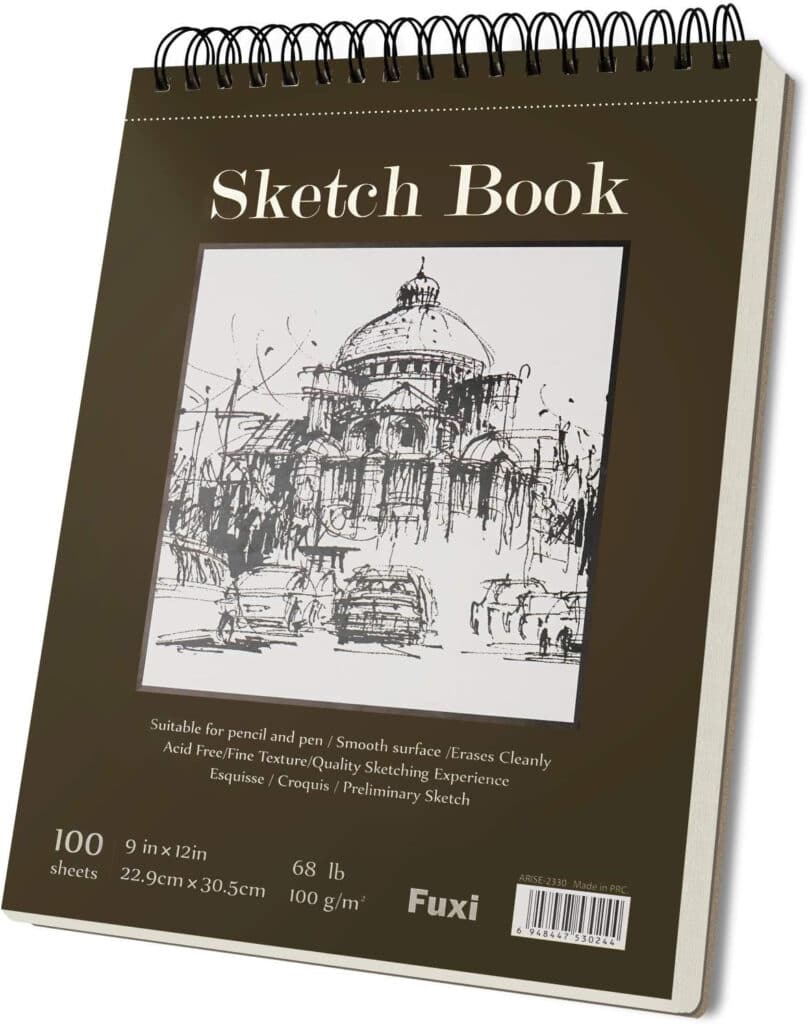
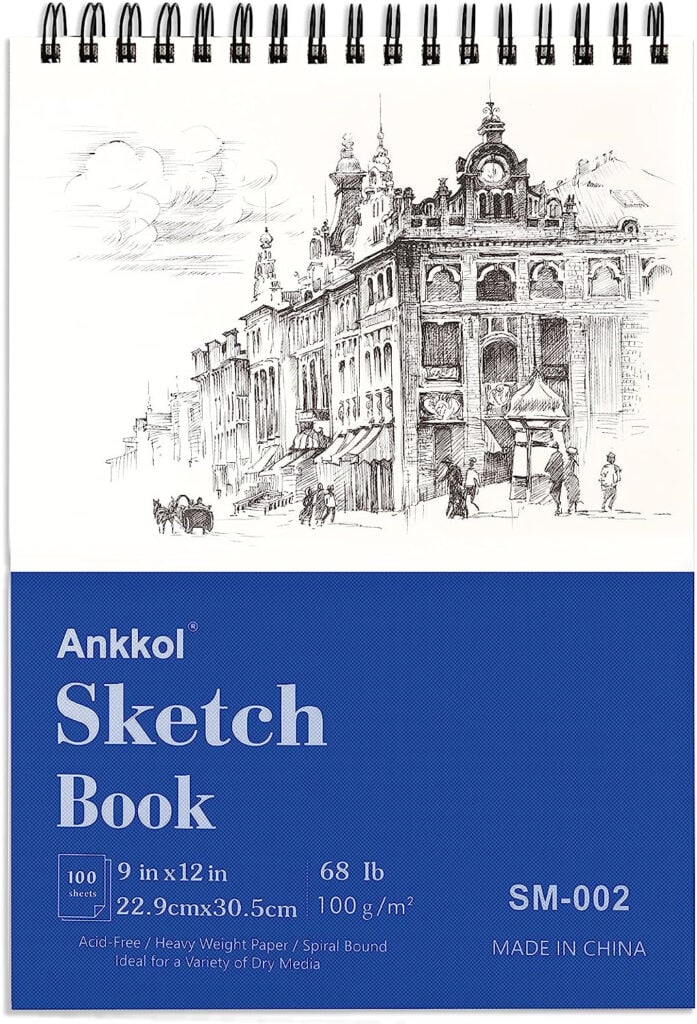
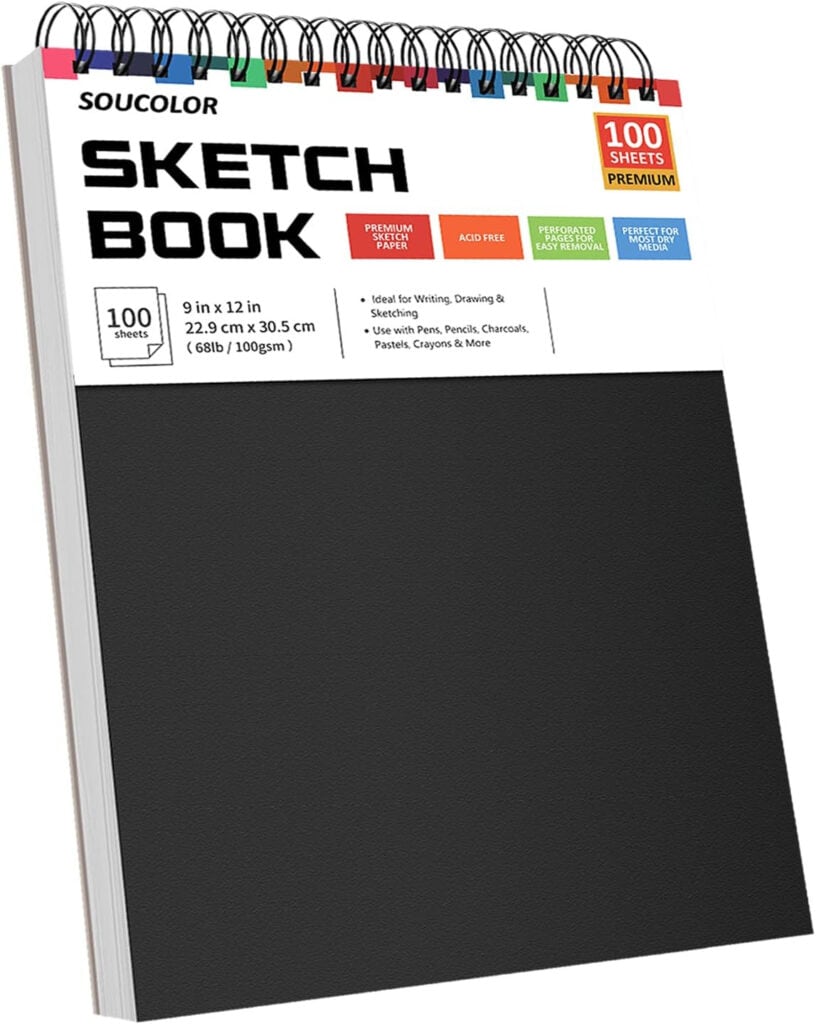
Common Use: Sketchbooks are beloved by artists, illustrators, and creative enthusiasts of all levels. They provide a platform for capturing spontaneous ideas, refining techniques, and experimenting with various artistic mediums. Whether used for pencil sketches, ink drawings, watercolors, or mixed media creations, a sketchbook is a safe haven for artistic exploration. (The 6 Best Custom Sketchbook Brands)
Pros:
- Creative Freedom: The blank pages encourage uninhibited artistic expression and experimentation.
- Portability: Sketchbooks come in various sizes, making them convenient companions for on-the-go creativity.
- Progress Tracking: Over time, sketchbooks become visual diaries, showcasing an artist’s growth and evolution.
- Versatility: Sketchbooks are suitable for a wide range of styles and mediums, from quick sketches to detailed illustrations.
Cons:
- Limited Space: Depending on the size, a sketchbook might offer a finite number of pages for artistic endeavors.
- Durability: With frequent use, the sketchbook’s cover and pages can show signs of wear and tear.
- No Erasing Permanent Marks: Some artists prefer to embrace imperfections, while others may find it challenging if they can’t erase certain mediums.
4.3 Subject Notebook
A subject notebook is a specialized organizational tool designed to streamline note-taking and information management across multiple subjects or topics. With its distinct sections and efficient layout, it enhances the process of categorizing and retrieving subject-specific notes.
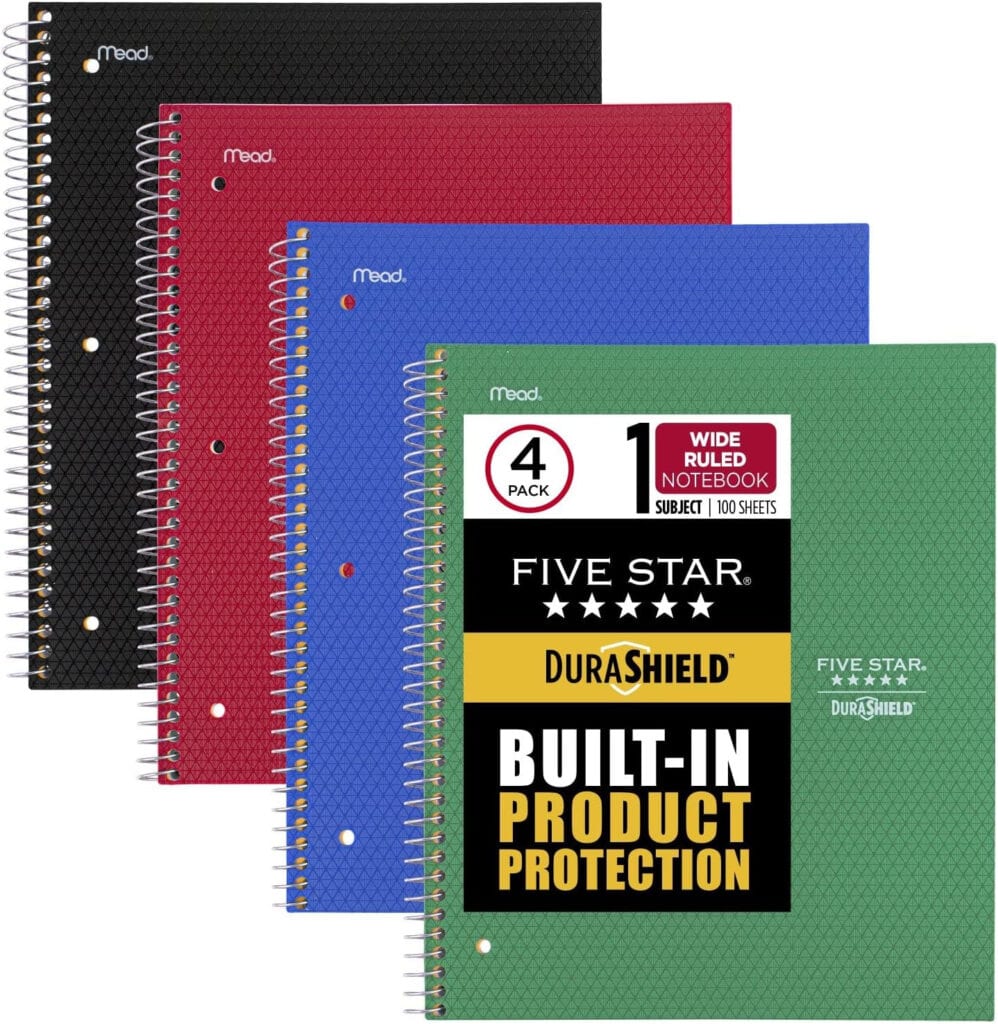
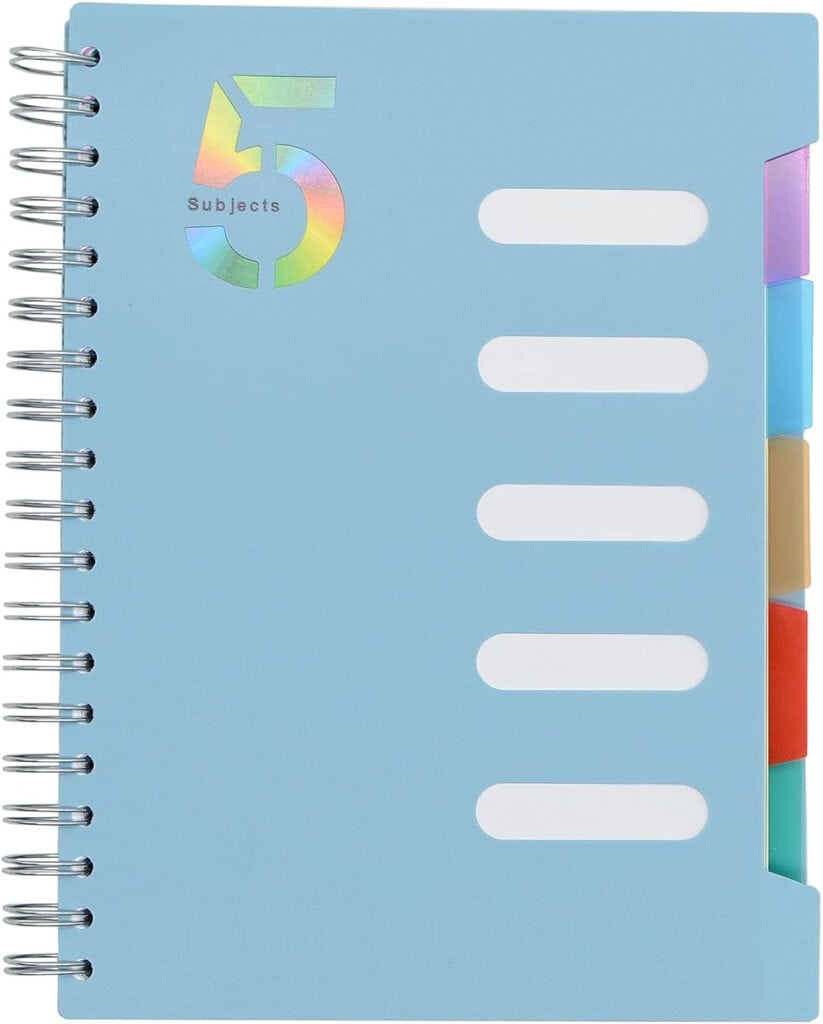
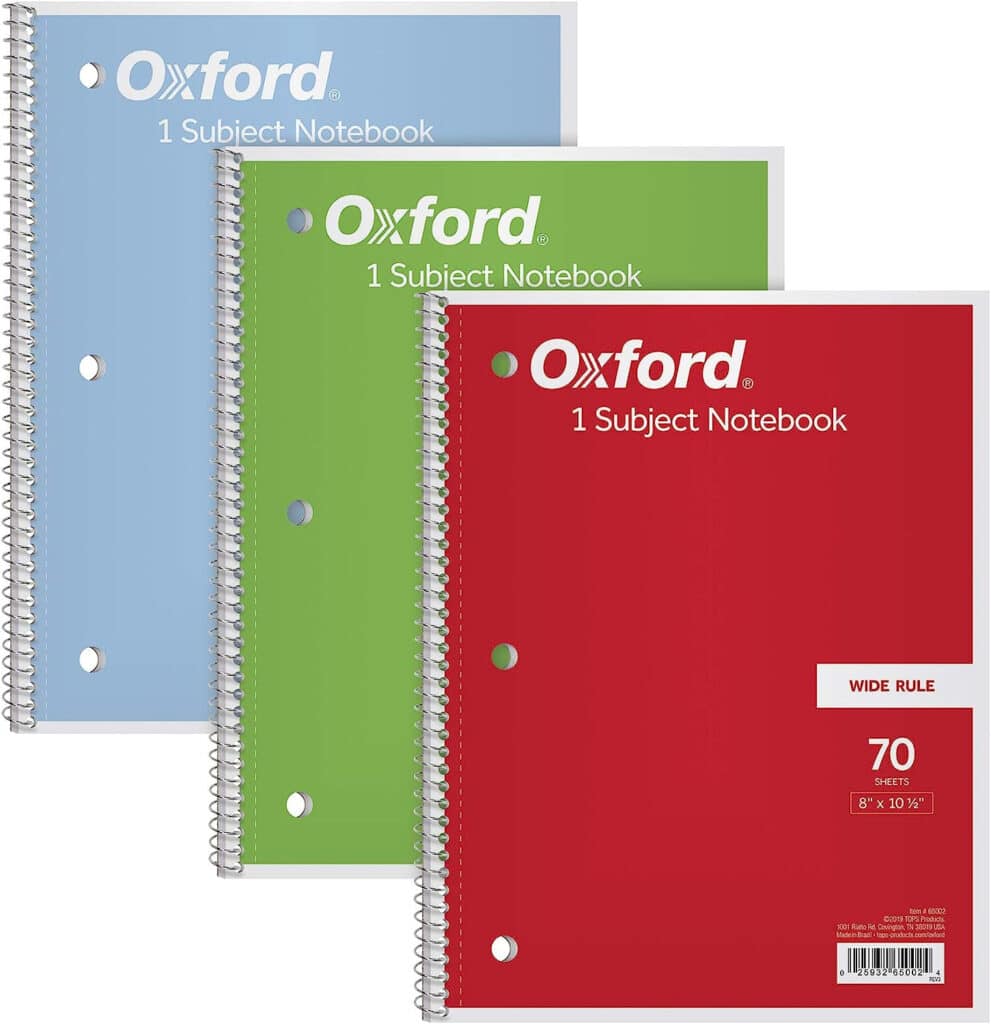
Common Use: Subject notebooks’ each section is dedicated to a specific subject, making it easy to keep notes, assignments, and relevant materials organized. Subject Notebooks are particularly valuable for academic study, research, and work presentations.
Pros:
- Enhanced Organization: The segmented sections allow for clear separation and categorization of notes.
- Efficient Retrieval: Finding specific information within the designated subject is quick and hassle-free.
- Focused Note-Taking: The structured layout encourages focused note-taking for each subject or topic.
- Consolidation: Subject Notebooks eliminate the need for carrying multiple notebooks, promoting a streamlined approach.
Cons:
- Bulkiness: Depending on the number of subjects, a Subject Notebook may become bulky over time.
- Subject Constraints: This may not be suitable for users who prefer integrated or interdisciplinary note-taking.
4.4 Planner Journals
Planner journals are dynamic tools that seamlessly combine the functionality of a planner with the expressive freedom of a journal. They offer a unique blend of structured organization and creative self-expression, making them an invaluable asset for managing time, setting goals, and reflecting on personal growth.
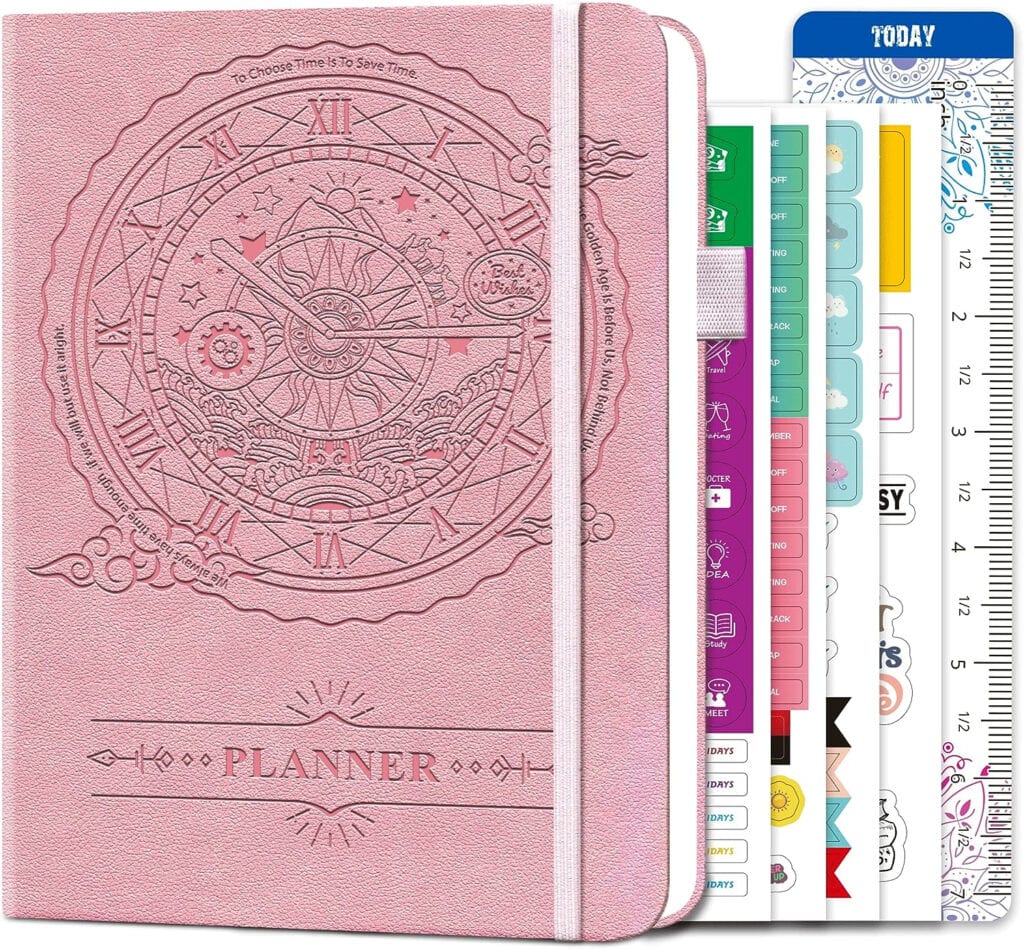

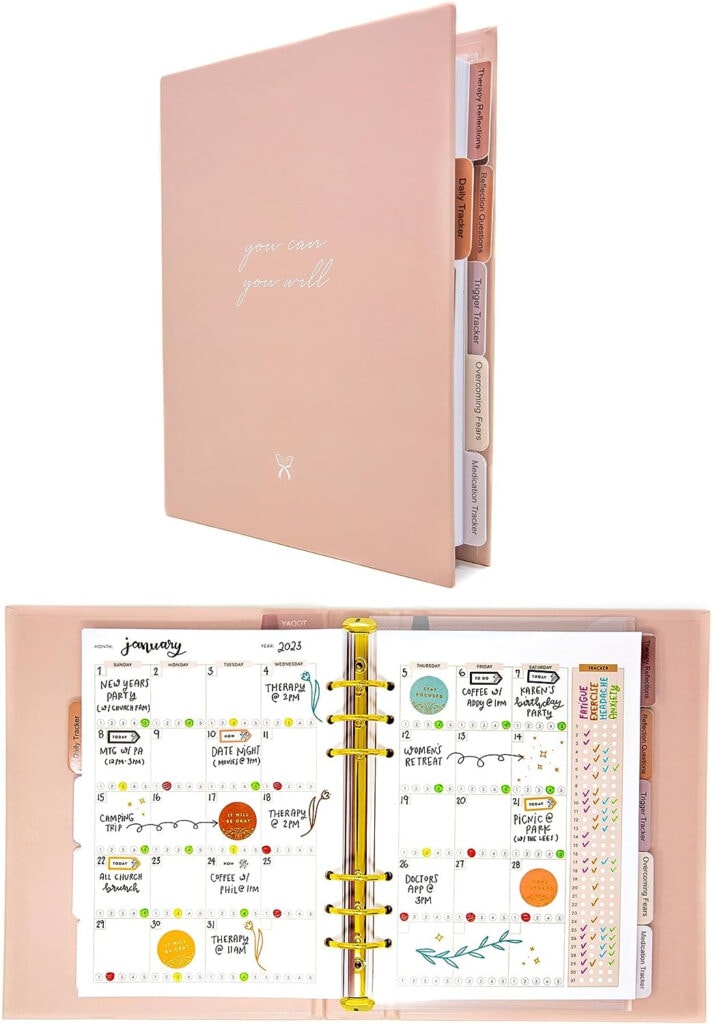
Common Use: Planner journals are embraced by individuals seeking a holistic approach to planning and self-discovery. They provide designated spaces for scheduling appointments, tracking tasks, and setting milestones, while also encouraging introspection and creative exploration. Planner journals are a valuable tool for anyone striving to balance their daily responsibilities with personal development.
Pros:
- Comprehensive Planning: Planner Journals offer dedicated sections for scheduling, goal-setting, and task management.
- Reflection and Mindfulness: Integrated prompts and spaces for reflection promote self-awareness and personal growth.
- Creative Outlet: The inclusion of blank pages allows for artistic expression, doodling, and free-form writing.
- Consolidation: Combining planning and journaling in a single book streamlines organization and fosters a holistic approach.
Cons:
- Learning Curve: Adjusting to the dual nature of planning and journaling may require adapting to new routines.
- Space Allocation: Balancing the amount of space for planning and journaling may vary depending on personal preferences.
4.5 Traveler’s Notebook
A traveler’s notebook is a versatile and customizable journaling system that adapts to your unique needs and wanderlust. With its modular design and artisanal charm, it becomes a loyal companion for recording memories, collecting mementos, and embarking on creative journeys.

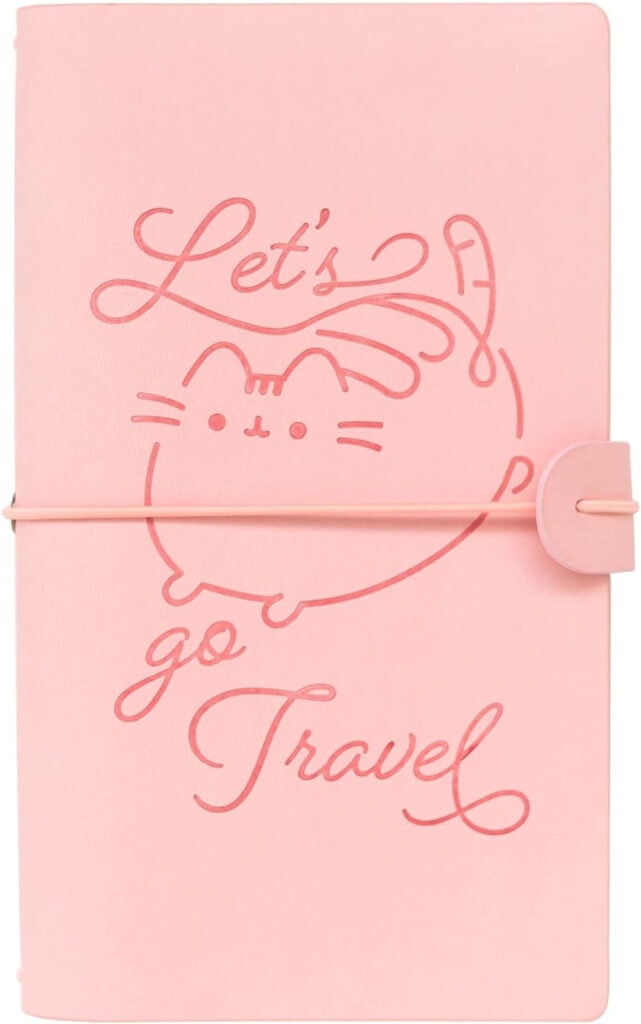
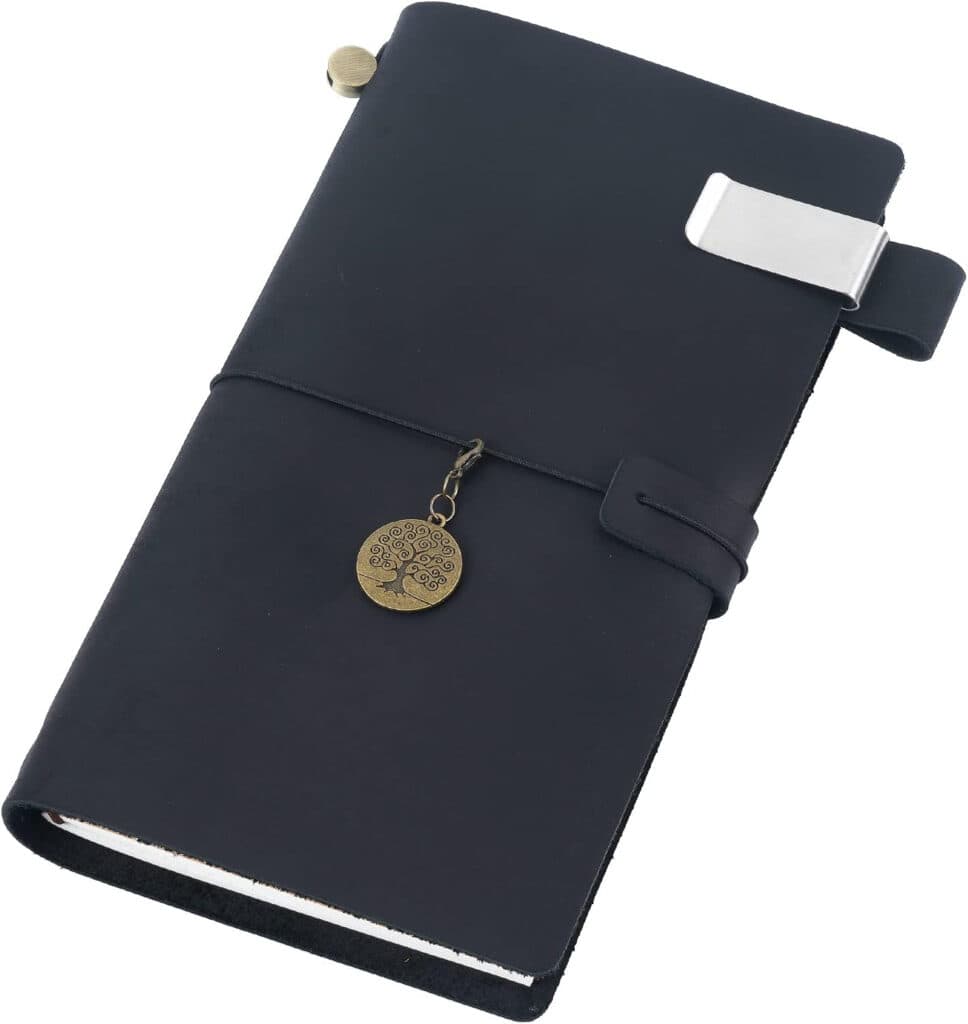
Common Use: Traveler’s notebooks are beloved by globetrotters, adventurers, writers, and dreamers who value both organization and artistic expression. They are ideal for chronicling travel experiences, sketching on the go, planning adventures, and documenting life’s moments. Traveler’s notebooks provide a personal and tactile way to capture memories while embracing a nomadic spirit.
Pros:
- Customizable Sections: Traveler’s Notebooks typically accommodate multiple inserts, allowing you to organize different aspects of your life.
- Artistic Versatility: The blank pages offer an inviting space for sketches, watercolors, collages, and creative writing.
- Compact Portability: The slim design makes it easy to slip into a bag or pocket, ensuring it’s always by your side.
Cons:
- Learning Curve: Assembling and customizing inserts may require some initial adjustment and experimentation.
- Bulkiness with Inserts: Depending on the number of inserts, a Traveler’s Notebook may become bulkier.
5. By Size
Notebooks come in a range of sizes, catering to different preferences, portability needs, and usage scenarios. The size of a notebook can impact its usability, convenience, and versatility. Let’s explore how types of notebooks can be categorized based on their sizes.
5.1 Pocket Notebook
A pocket notebook is a compact and portable writing companion, designed to fit conveniently into pockets, bags, or small spaces. Despite its small size, it offers a practical solution for capturing ideas, notes, and sketches on the go.
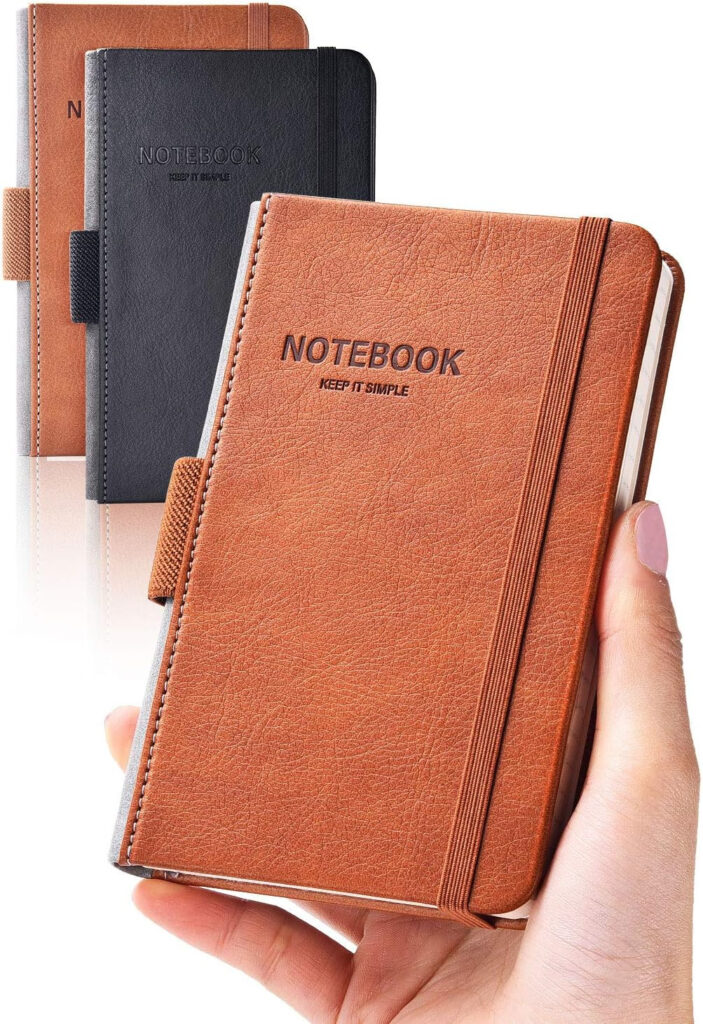
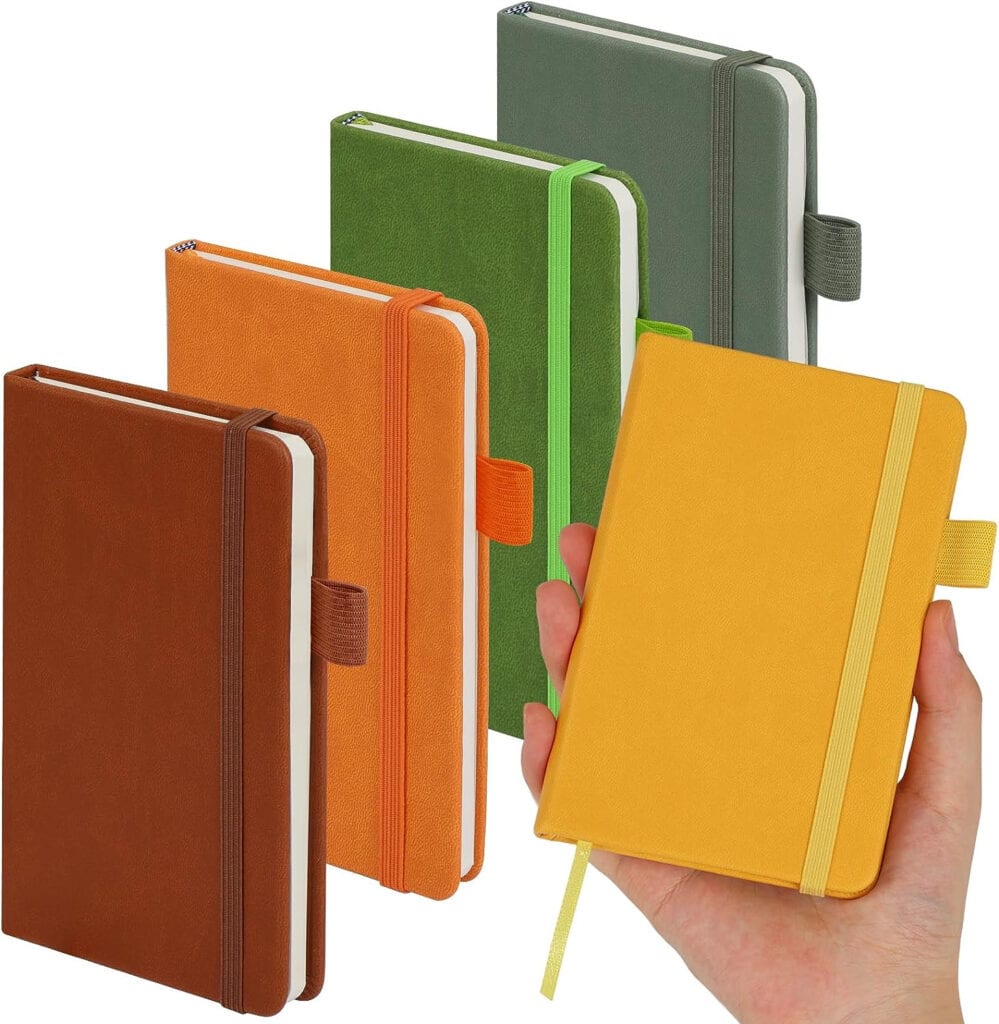
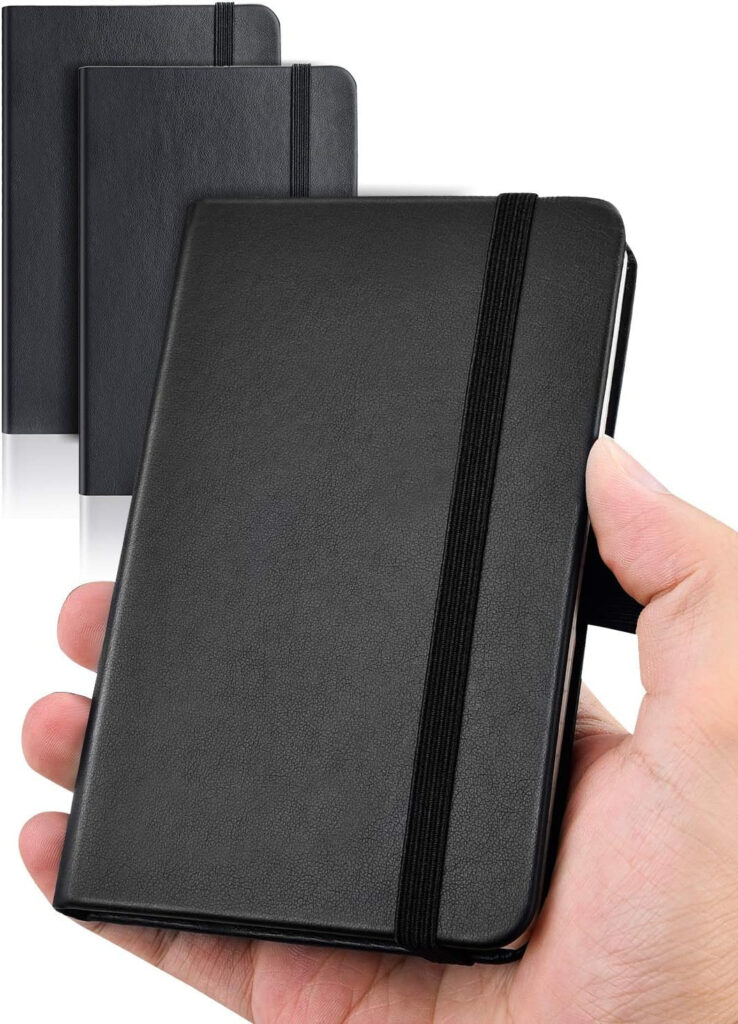
Common Use: Pocket notebooks are popular among individuals who require a lightweight and easily accessible writing tool. They are ideal for jotting down quick thoughts, making to-do lists, recording memos, and sketching spontaneous inspirations. Pocket Notebooks are often favored by travelers, professionals, and creatives who value mobility.
Pros:
- Portability: The compact size ensures you always have a writing tool at hand, no matter where you are.
- Convenience: Pocket Notebooks are easy to carry and can be discreetly used in various situations.
- Spontaneity: Their small size encourages quick and impromptu note-taking and sketching.
Cons:
- Limited Space: The small dimensions may limit the amount of content you can capture on each page.
- Not Ideal for Elaborate Work: Complex drawings or lengthy notes might be challenging due to the compact size.
- Durability: Frequent use and being carried around may lead to wear and tear over time.
5.2 A5 Notebook
An A5 notebook is a popular and versatile writing instrument that falls within the A paper size category. With its balanced dimensions, it offers a harmonious blend of portability and ample writing space, making it a favored choice for a variety of tasks.
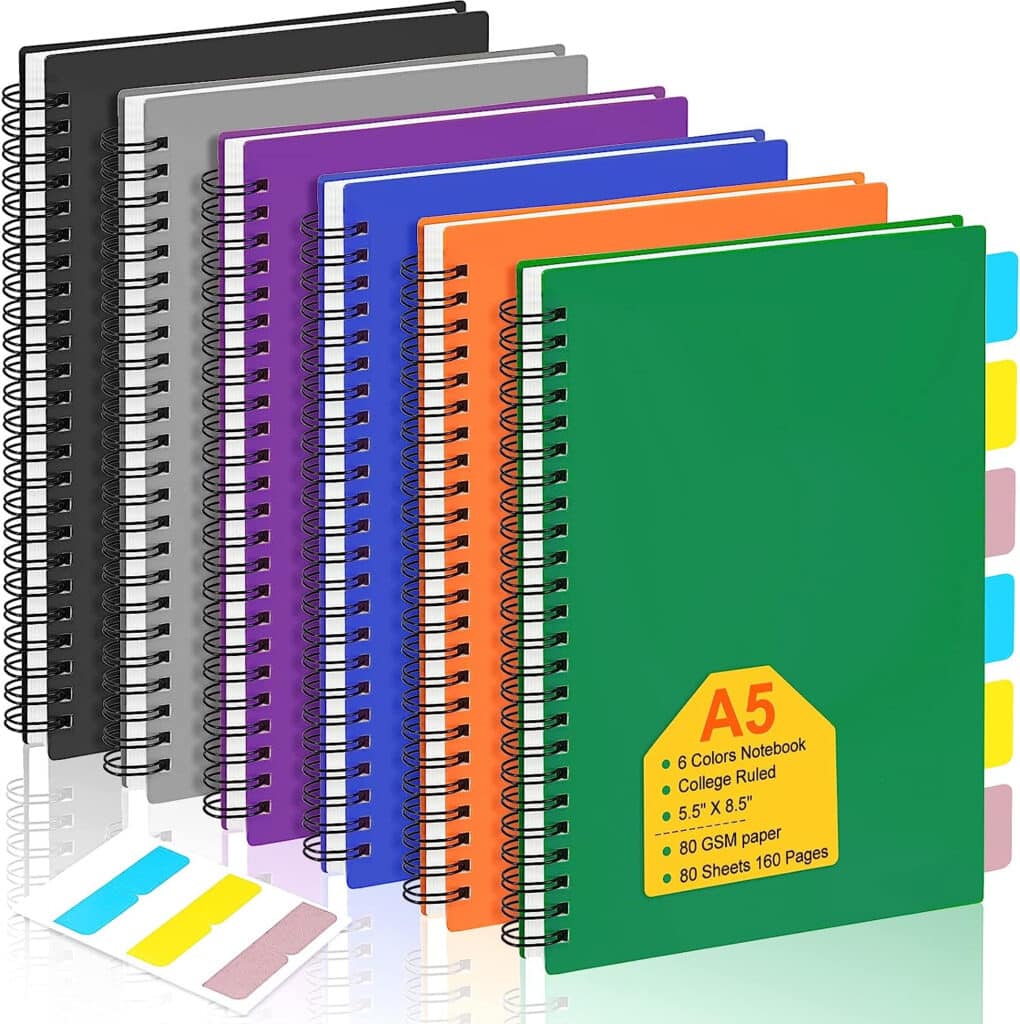
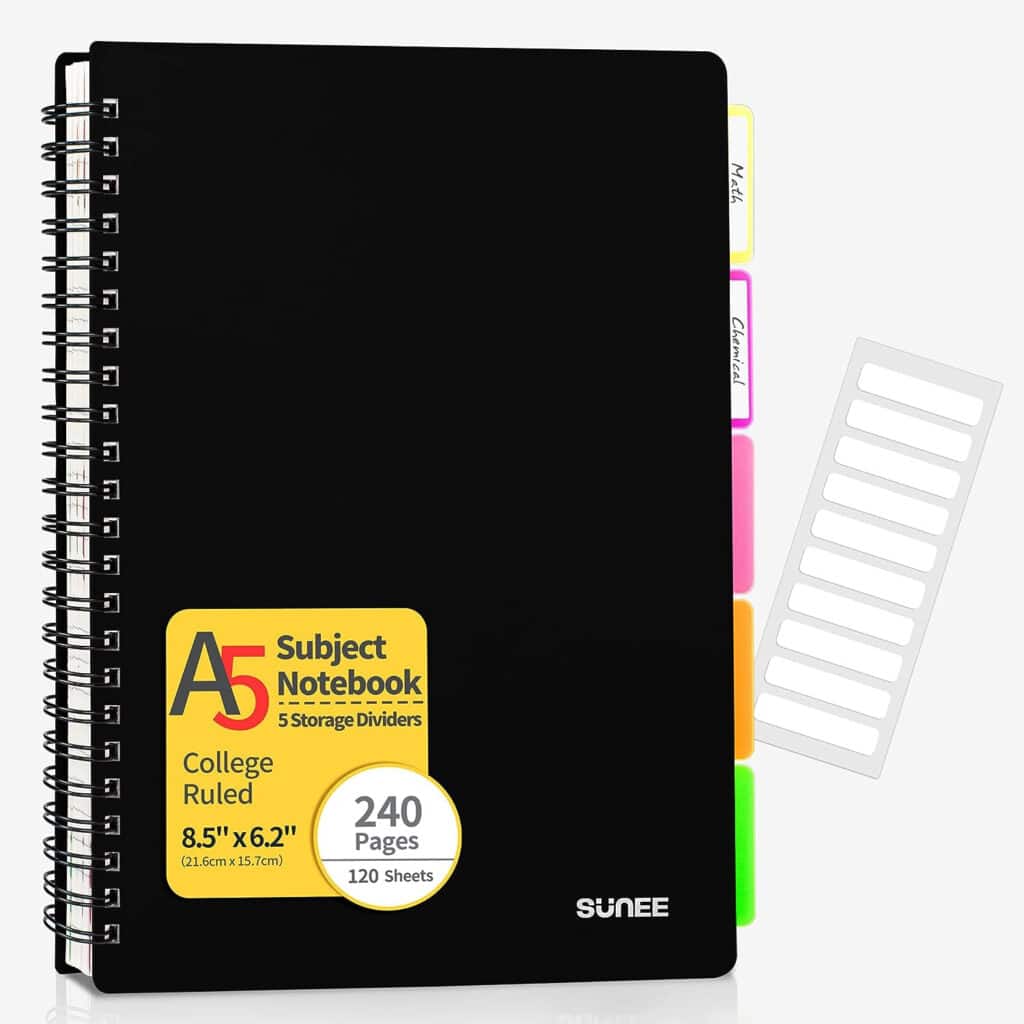
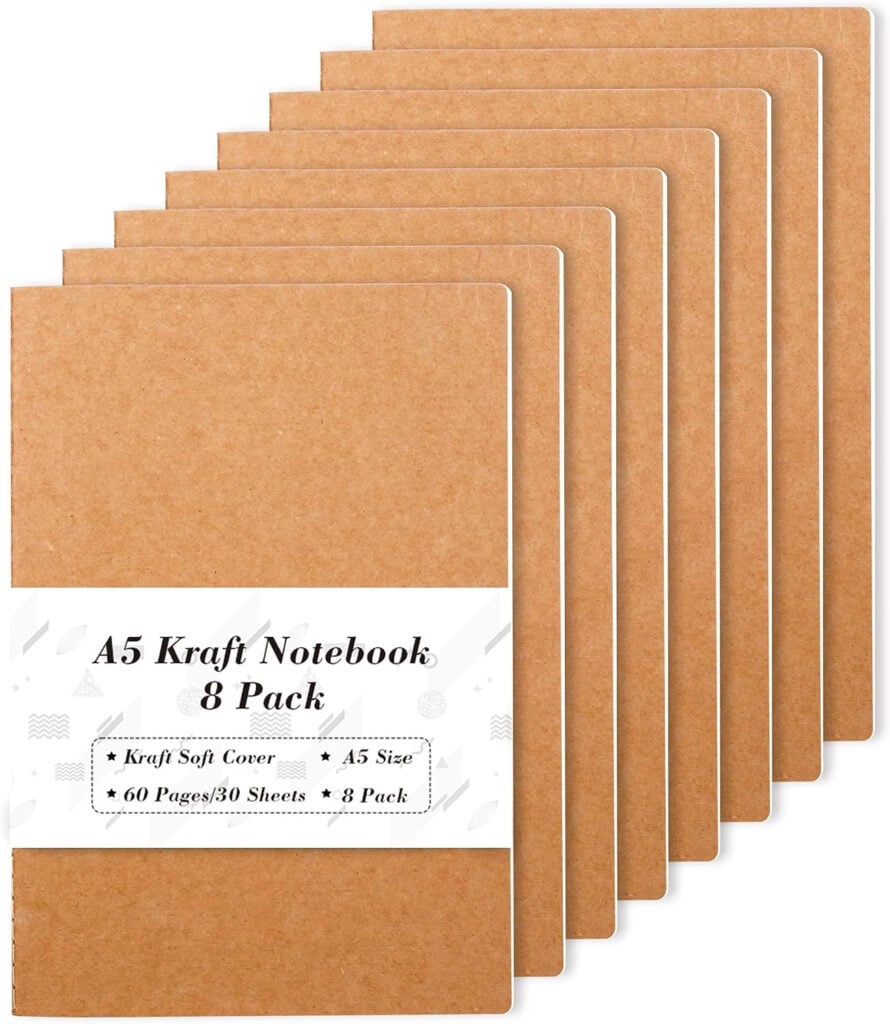
Common Use: A5 notebooks are embraced by students, professionals, and creatives for their versatility. They are ideal for note-taking, journaling, sketching, and organizing thoughts. The A5 size strikes a balance between being compact enough to carry around and spacious enough to accommodate substantial content.
Pros:
- Portable: The A5 size is convenient for on-the-go use, fitting easily into bags or briefcases.
- Sufficient Writing Space: The dimensions provide enough room for detailed notes, sketches, and drawings.
- Organizational Flexibility: A5 Notebooks are suitable for structuring tasks, managing projects, and creating to-do lists.
- Practical Size: The A5 size strikes a balance between being compact and offering comfortable readability.
Cons:
- Size Limitations: For elaborate artworks or extensive writing projects, the A5 size might feel restrictive.
- Not as Compact as Pocket Notebooks: While portable, A5 Notebooks are not as small as dedicated pocket-sized options.
The above are several common types of notebooks in different sizes. If you want to know more, please click here: Notebook Sizes: The Ultimate FAQ Guide.
6. By Special Features
Notebooks can offer a variety of special features that enhance their functionality and cater to specific needs. These unique features can make a notebook more versatile, user-friendly, and tailored to specific tasks. Let’s explore how types of notebooks can be categorized based on their special features.
6.1 Waterproof Notebook
A waterproof notebook is a resilient and innovative writing tool designed to withstand exposure to water, making it a reliable choice for outdoor adventures, travel, and environments prone to moisture. With its durable construction, it ensures your notes and ideas remain intact even in challenging conditions.
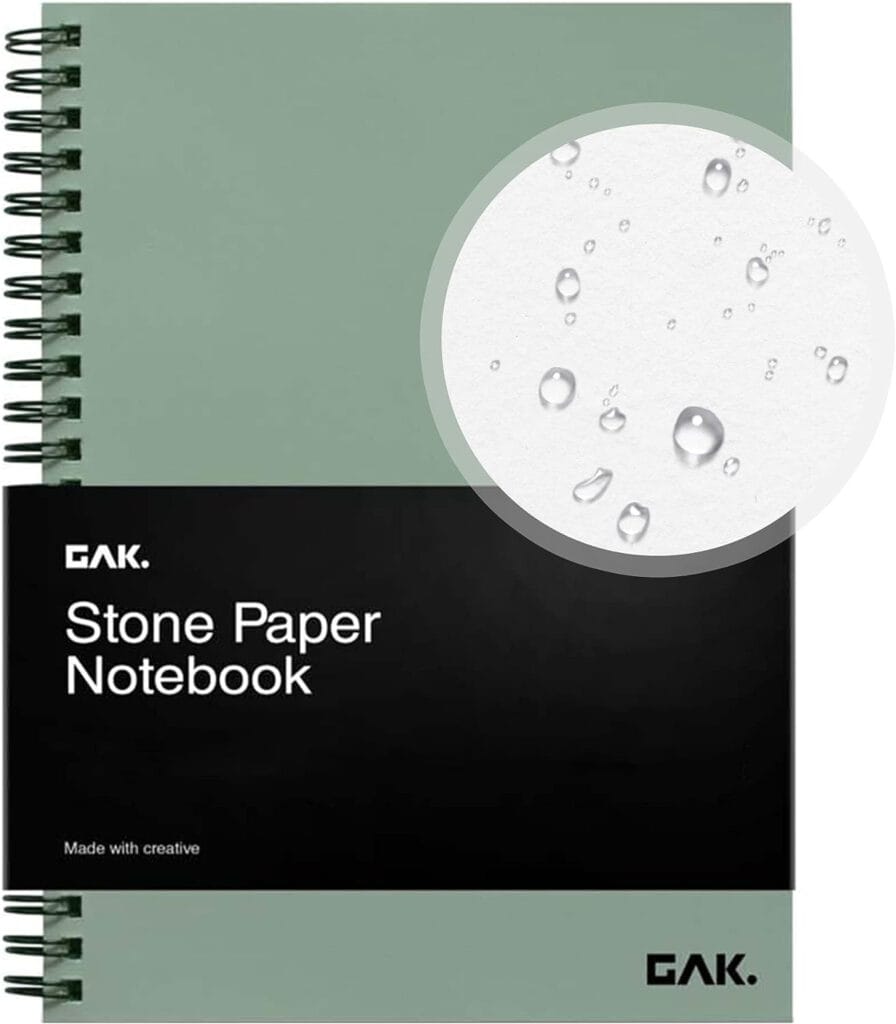
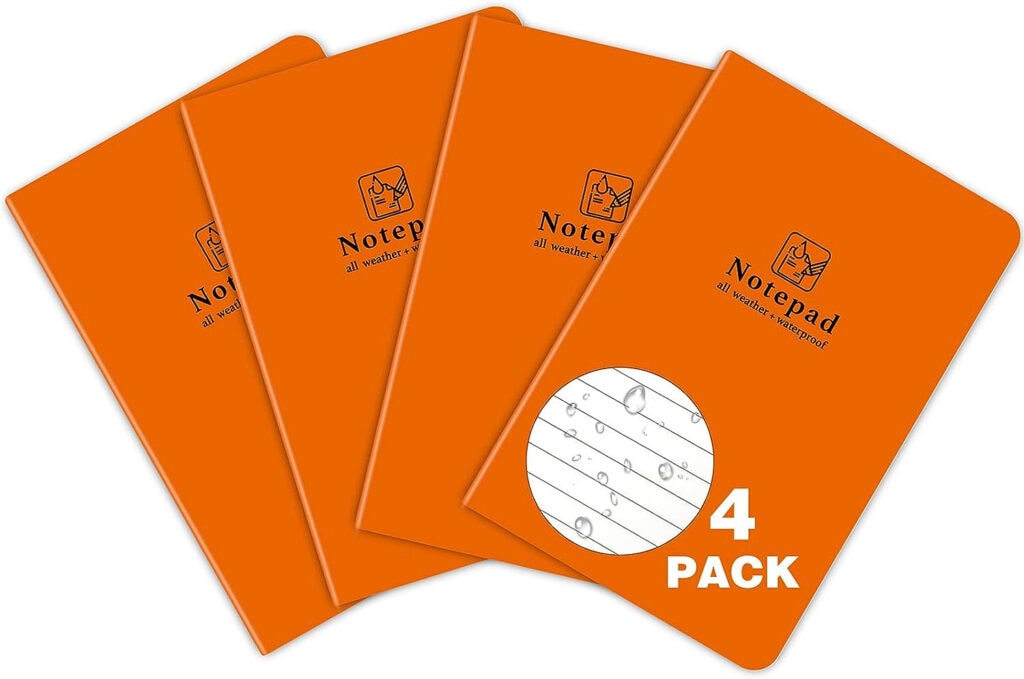
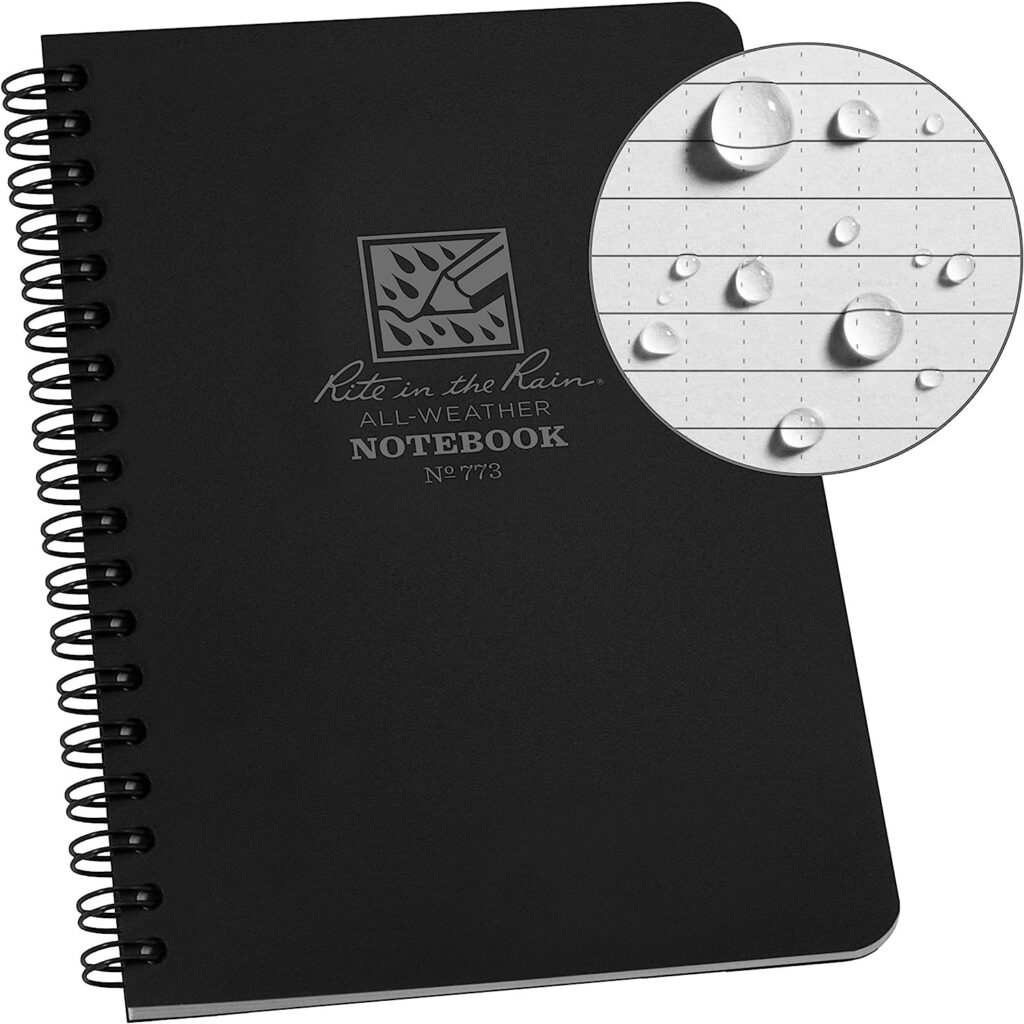
Common Use: Waterproof notebooks are embraced by outdoor enthusiasts, travelers, field researchers, and anyone who requires a writing companion in wet or unpredictable environments. They are ideal for jotting down observations, recording data, and documenting experiences while exploring nature, engaging in water-based activities, or navigating rainy conditions. (Everything You Need to Know about Waterproof Notebooks)
Pros:
- Water Resistance: The waterproof material protects your notes from rain, spills, and accidental submersion in water.
- Durability: Waterproof Notebooks are built to withstand wear and tear, ensuring your writings endure.
- Outdoor Adaptability: They are perfect companions for camping, hiking, kayaking, and other outdoor pursuits.
- Versatility: Waterproof Notebooks are suitable for various writing instruments, including pencils and waterproof pens.
Cons:
- Limited Texture Variety: The waterproof material might have a different feel compared to traditional paper.
- Potential Smudging: Depending on the ink type, there may be a slight risk of smudging when writing.
6.2 Recycled Notebook
A recycled notebook is an eco-friendly and sustainable writing tool crafted from recycled materials, contributing to the reduction of environmental impact. With its commitment to conservation, it provides a conscious choice for individuals seeking to align their writing practices with environmental values.
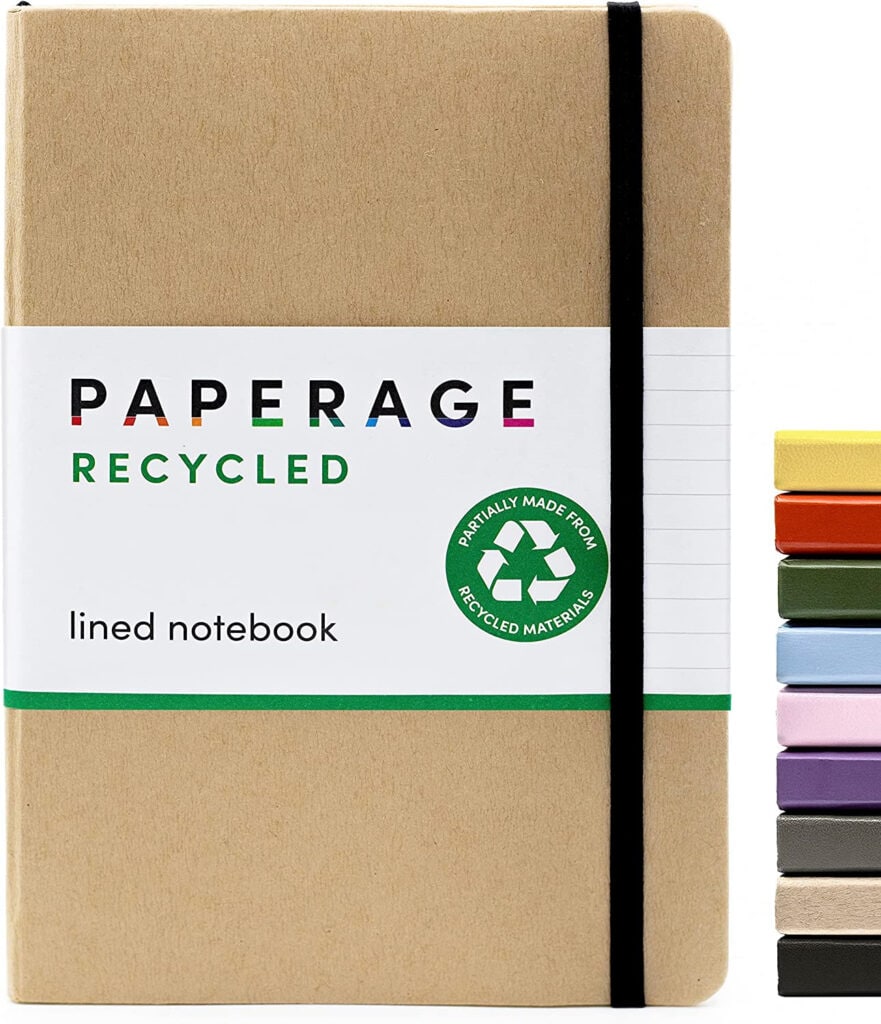

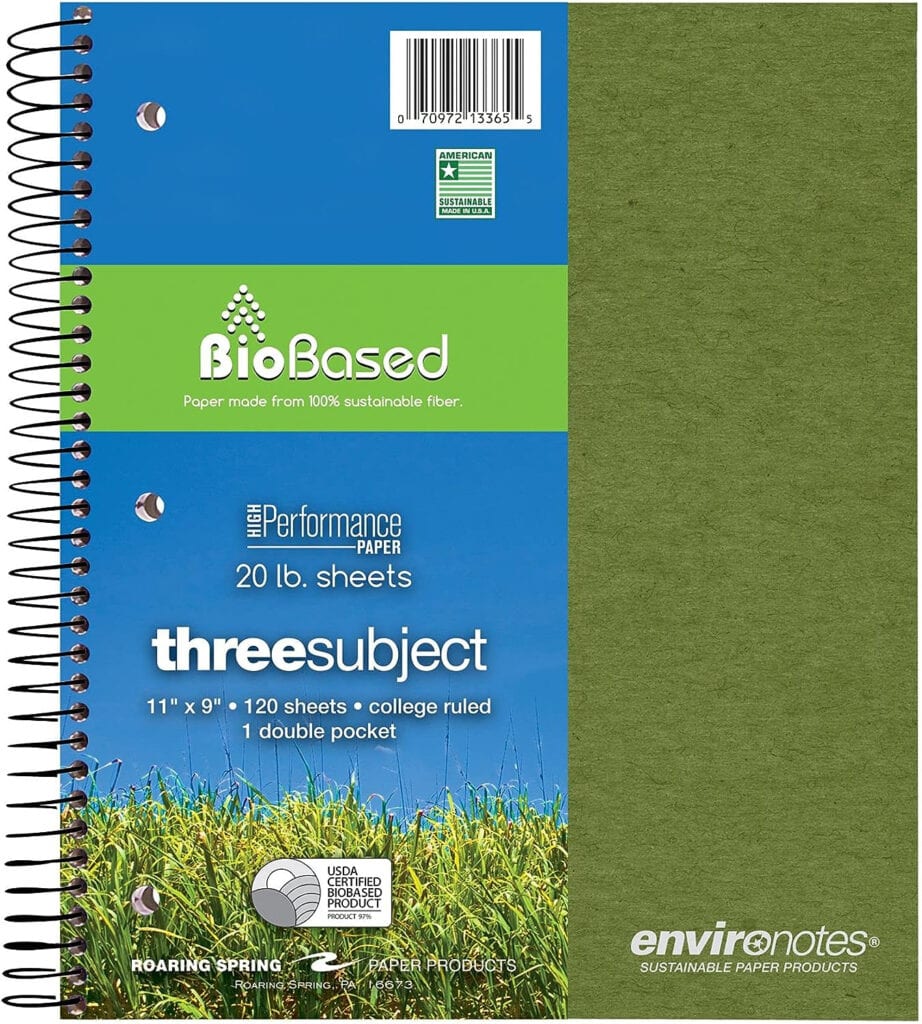
Common Use: Recycled notebooks are embraced by environmentally conscious individuals, students, professionals, and anyone who prioritizes sustainability. They are ideal for note-taking, journaling, sketching, and any form of creative expression. Recycled Notebooks offer a way to reduce the demand for new resources while supporting recycling efforts. (Recycled Paper Notebooks: The Most Comprehensive Guide)
Pros:
- Environmental Impact: Recycled notebooks contribute to reducing waste and conserving natural resources.
- Sustainability: Choosing recycled materials supports eco-friendly practices and encourages responsible consumption.
- Quality Writing Surface: Many recycled notebooks offer a high-quality writing experience comparable to non-recycled counterparts.
- Ethical Choice: Using recycled materials promotes awareness and encourages positive environmental change.
Cons:
- Variability: The appearance and texture of recycled paper may vary depending on the source of materials.
- Availability: Finding a specific style or design for a Recycled Notebook may be more limited compared to traditional options.
6.3 Left-Handed Notebooks
Left-Handed notebooks are thoughtfully designed writing tools tailored to the needs of left-handed individuals. With their unique layout and features, they provide a comfortable and efficient writing experience, accommodating the natural writing motion of left-handed writers.
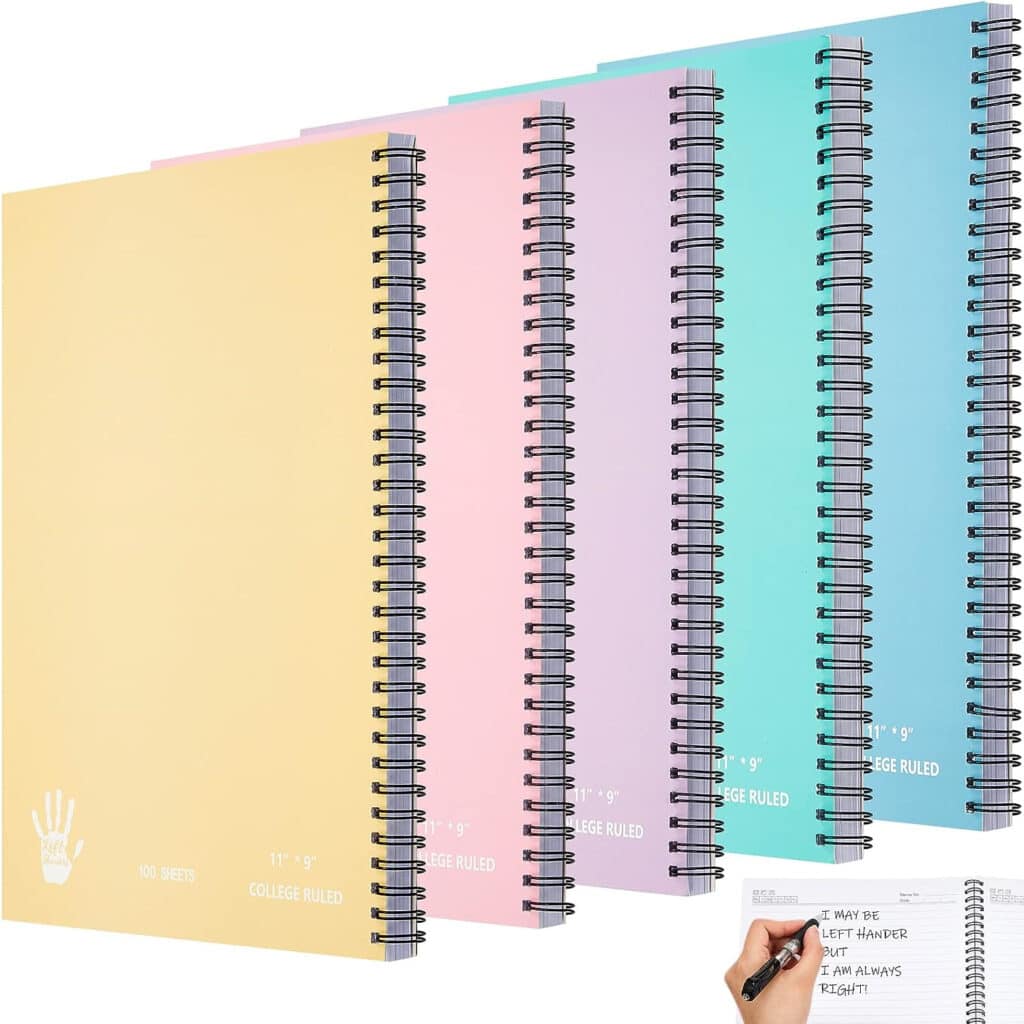
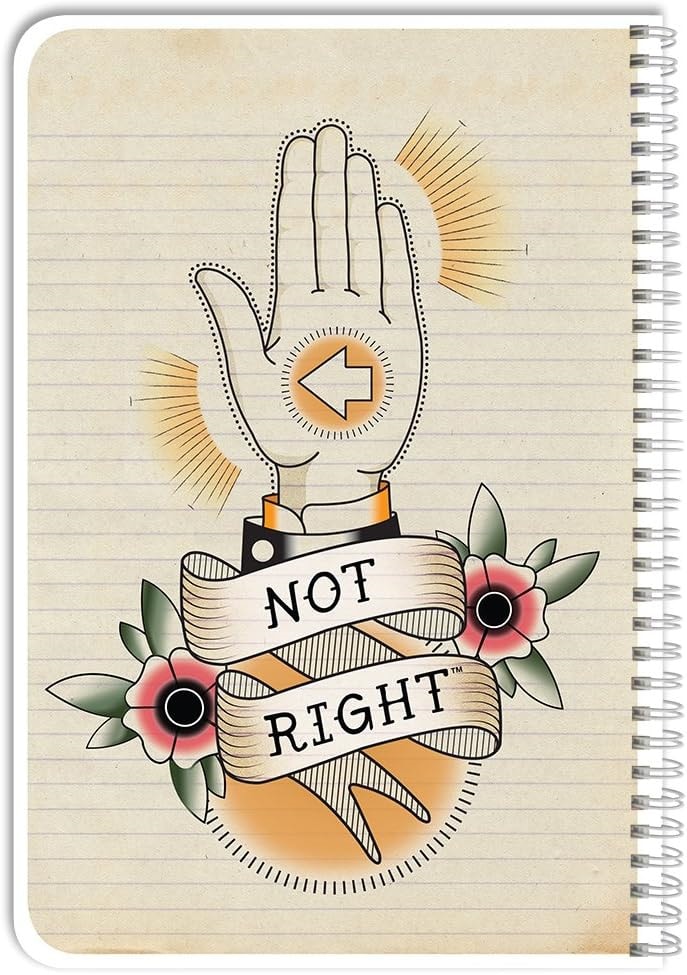
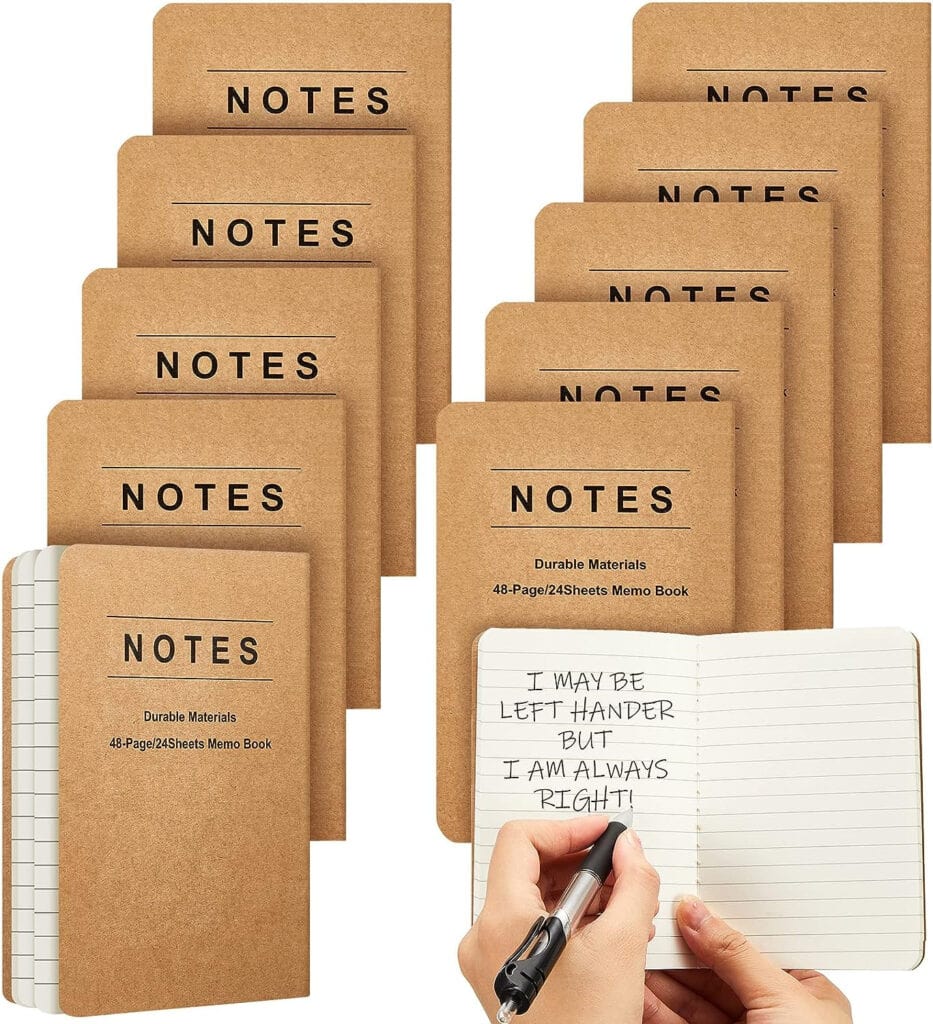
Common Use: Left-Handed notebooks are embraced by left-handed individuals who often struggle with smudging and discomfort when using standard notebooks. They are ideal for note-taking, sketching, and any form of writing. Left-Handed Notebooks cater to the specific needs of left-handed writers, enhancing their overall writing experience.
Pros:
- Spiral Placement: Left-Handed Notebooks typically feature a spiral binding on the right side, minimizing interference while writing.
- Quick-Drying Ink: Many Left-Handed Notebooks use ink that dries quickly, reducing the chances of smudging.
- Comfortable Writing: The design ensures a more ergonomic and comfortable writing experience for left-handed users.
Cons:
- Availability: Left-Handed Notebooks may have a more limited selection compared to standard notebooks.
- Adaptation: Switching to a specialized layout may require some adjustment for left-handed writers.
6.4 Digital Notebook
A digital notebook represents the modern evolution of traditional paper notebooks, offering a versatile and technologically enhanced platform for organizing, creating, and storing digital content. With its digital interface, it seamlessly integrates with the digital landscape, catering to a tech-savvy generation.
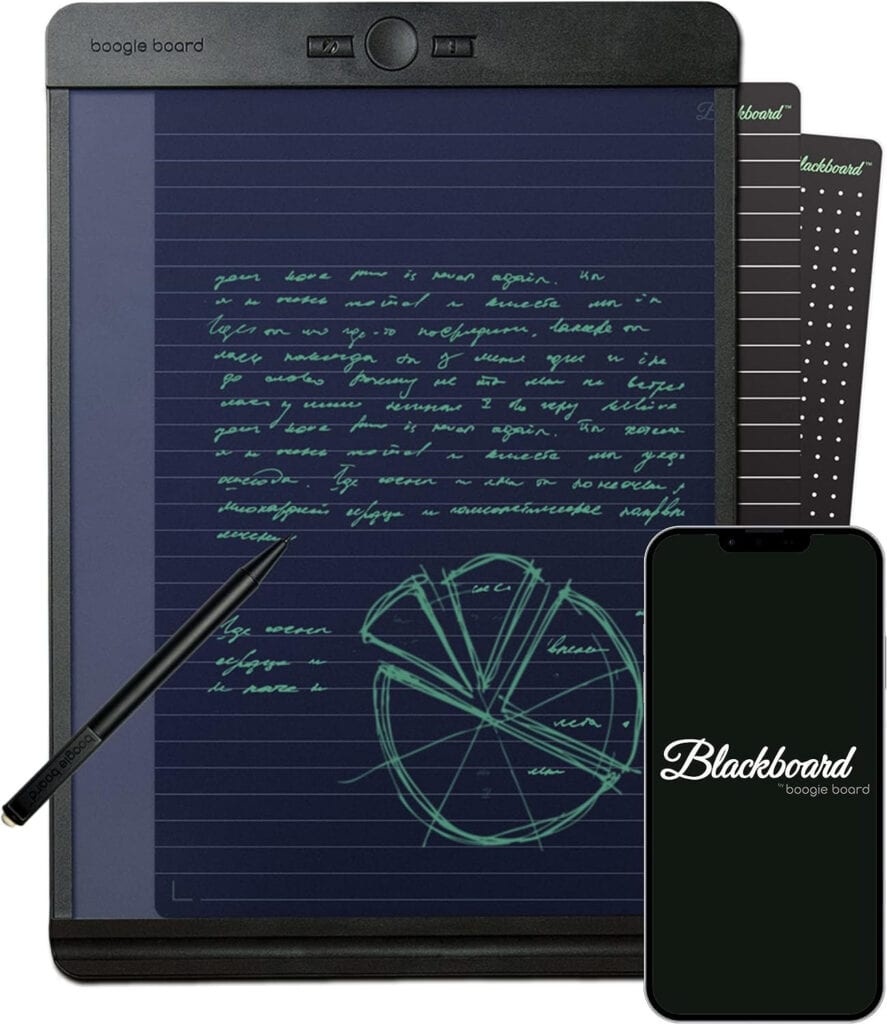
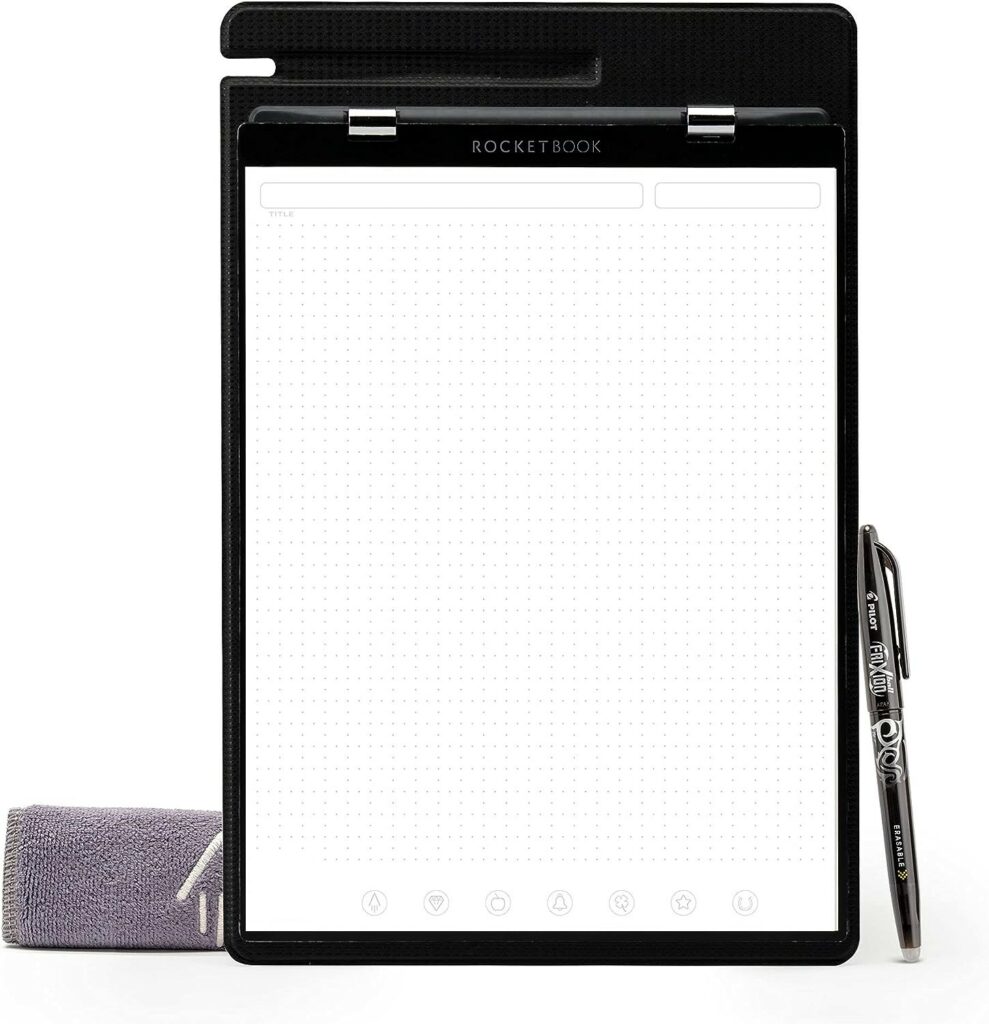
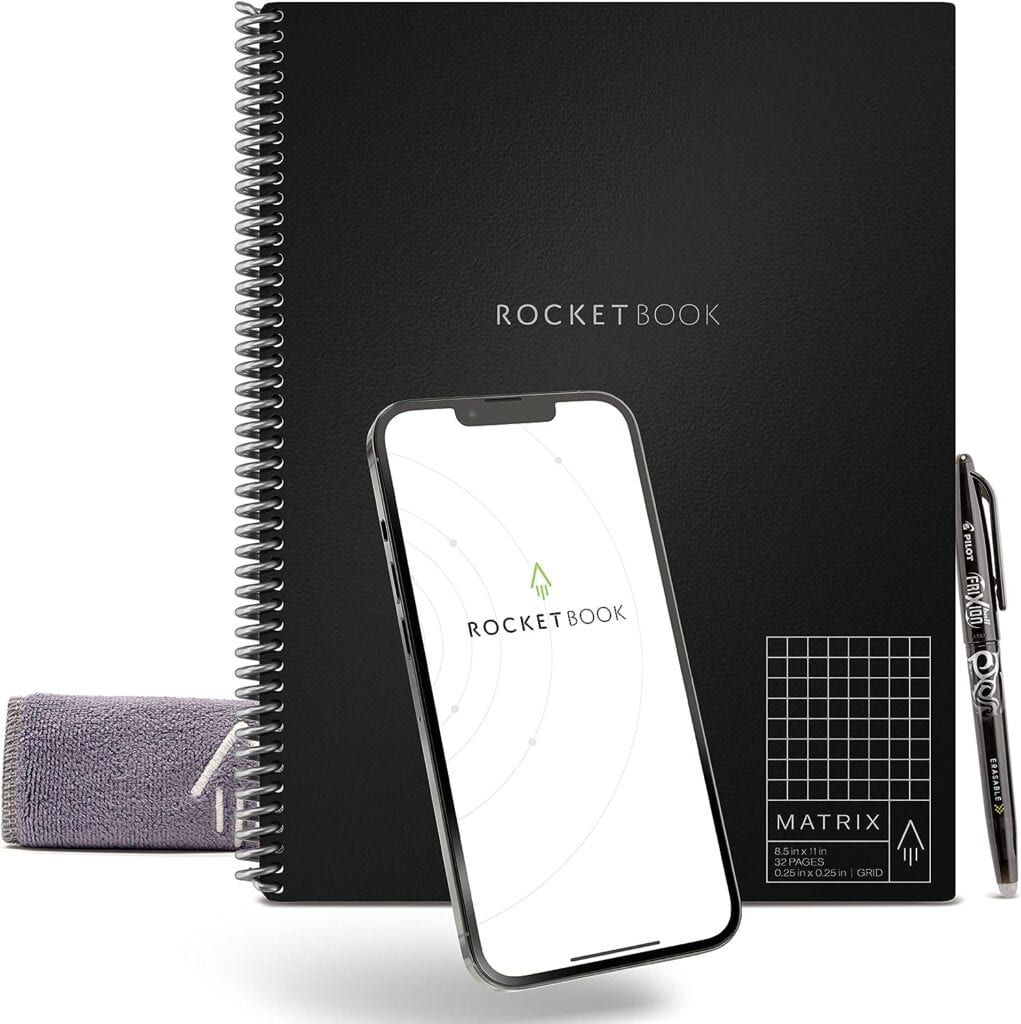
Common Use: Digital notebooks are embraced by professionals, students, and creatives who prefer digital tools for note-taking, brainstorming, sketching, and project management. They provide a dynamic canvas for combining text, images, drawings, and multimedia elements. Digital notebooks are especially popular in remote work and educational settings.
Pros:
- Endless Storage: Digital Notebooks offer virtually limitless storage space for notes, sketches, and documents.
- Flexibility: The ability to rearrange, edit, and duplicate content fosters a flexible and customizable workspace.
- Searchability: Built-in search functions make it easy to find specific notes or information within the notebook.
- Collaboration: Many digital notebook platforms allow real-time collaboration and sharing with others.
Cons:
- Learning Curve: Some users may need time to adapt to the digital interface and its features.
- Dependency on Technology: This relies on electronic devices and software, which might not suit everyone’s preferences.
- Distraction Potential: The digital environment may have more distractions compared to traditional paper notebooks.
From traditional spiral-bound notebooks to innovative digital counterparts, the world of notebooks is diverse and exciting. The right notebook can elevate your writing experience and capture your thoughts in a tangible form, allowing you to explore your creativity and stay organized.
Explore the diverse world of notebooks and find the perfect one to accompany your writing journey. Whether you’re a seasoned writer, an artist, a student, or simply someone who loves putting pen to paper, there’s a notebook tailored just for you. Embrace the tactile joy of writing and watch as your ideas come to life on the pages of your chosen notebook.
Custom Notebook

A custom notebook is a personalized and uniquely tailored writing tool that allows you to create a notebook that reflects your individual style, preferences, and needs. Honeyoung, as a notebook factory that can produce customized books, becomes a one-of-a-kind platform for capturing thoughts, ideas, and creativity.

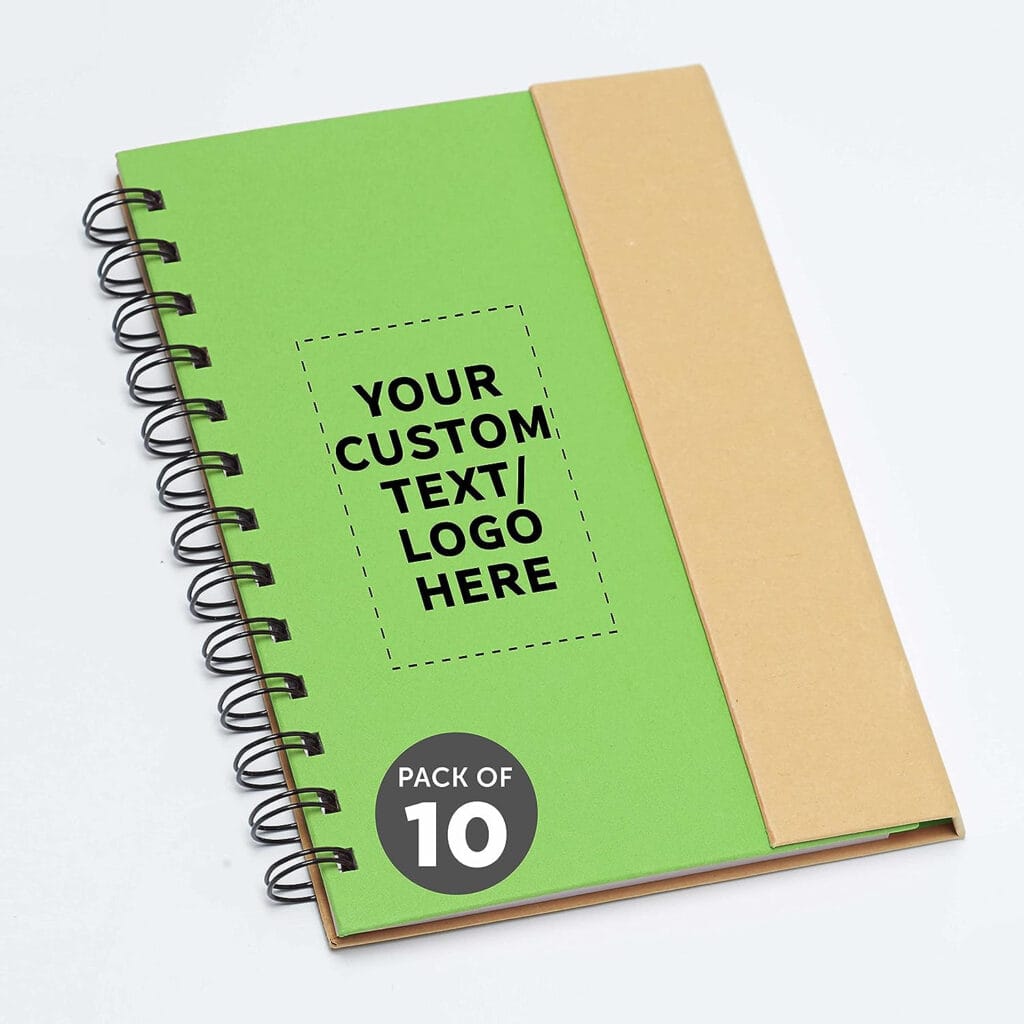

Common Use: Custom notebooks are embraced by individuals who seek a truly unique writing experience. They are ideal for a variety of purposes, including journaling, branding, promotional giveaways, and special occasions. Custom Notebooks offer a way to infuse your personality into your stationery and make a statement.
Pros:
- Personal Expression: Custom notebooks allow you to choose the cover design, paper type, size, and other features.
- Brand Identity: Custom Notebooks can be branded with logos, colors, and themes for business or promotional purposes.
- Memorable Gifts: Custom Notebooks make thoughtful and memorable gifts for loved ones and special occasions.
- Tailored Functionality: You can design layouts that cater to specific needs, such as bullet journaling or project planning.
Cons:
- Cost: Depending on the level of customization and materials used, custom notebooks may be pricier than standard options.
- Design Decisions: The design process may require some decisions if you’re seeking a unique layout.
Types of Notebooks: FAQs

Q: Can I use a dotted notebook for regular writing?
A: Absolutely! Dotted notebooks offer a subtle guide for neat writing, making them versatile for various purposes.
Q: Are sketchbooks only for artists?
A: Not at all. Sketchbooks are great for anyone who wants to doodle, jot down ideas, or unleash their creativity.
Q: Can I use a traveler’s notebook for daily journaling?
A: Yes, traveler’s notebooks are perfect for journaling your daily experiences and thoughts, especially if you’re always on the go.
Q: Are digital notebooks secure?
A: Many digital notebook apps offer security features like encryption and password protection, ensuring the safety of your digital notes.
Q: Are there notebooks specifically designed for left-handed individuals?
A: Yes, several brands offer notebooks with left-handed-friendly features, such as spiral bindings on the right side and paper that prevents smudging.
Q: Can I use fountain pens in all types of notebooks?
A: While many notebooks can handle fountain pen ink, it’s advisable to choose notebooks with thicker, high-quality paper to prevent feathering and bleeding.
Q: Are digital notebooks secure for storing sensitive information?
A: Most reputable digital notebook apps offer encryption and security features to protect your sensitive data from unauthorized access.
Q: Can I personalize the cover of my notebook?
A: Absolutely! Many manufacturers offer customizable notebook covers, allowing you to add your name, logo, or design.

